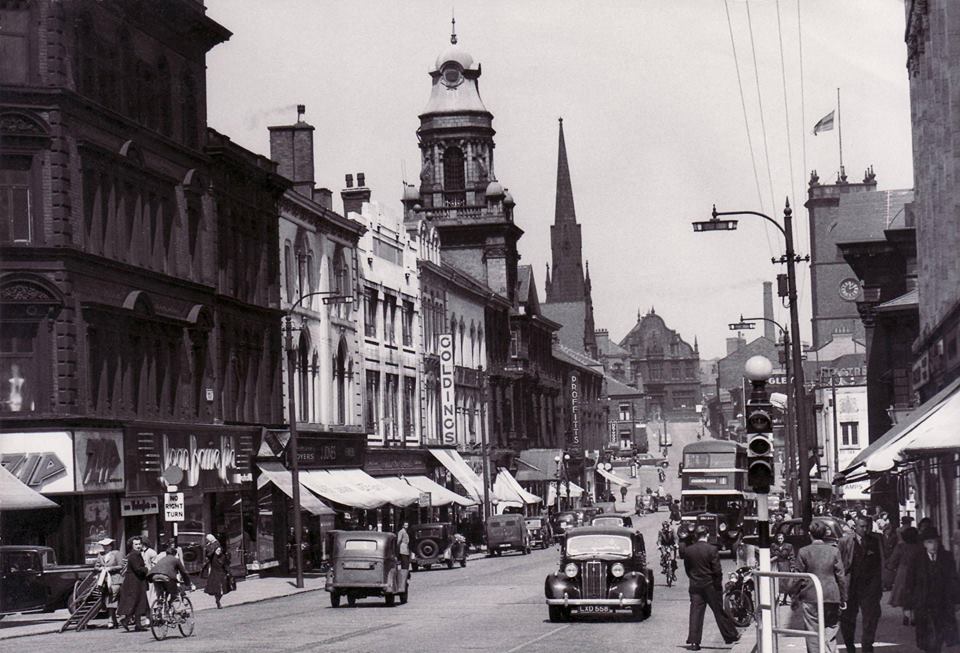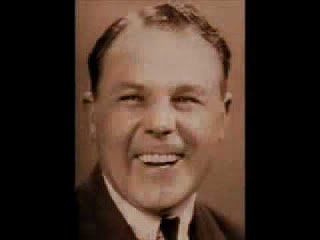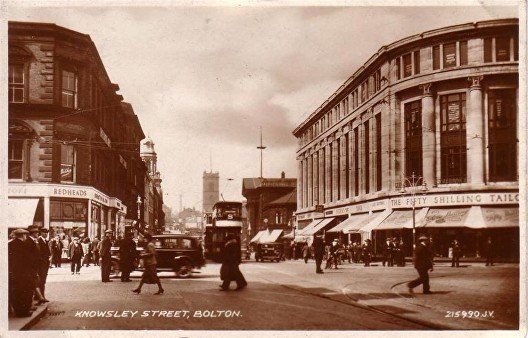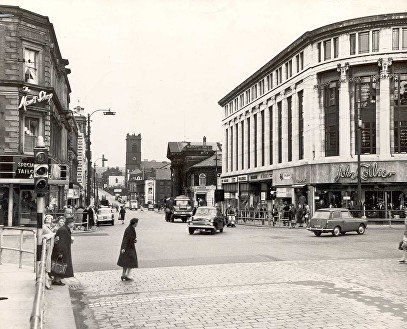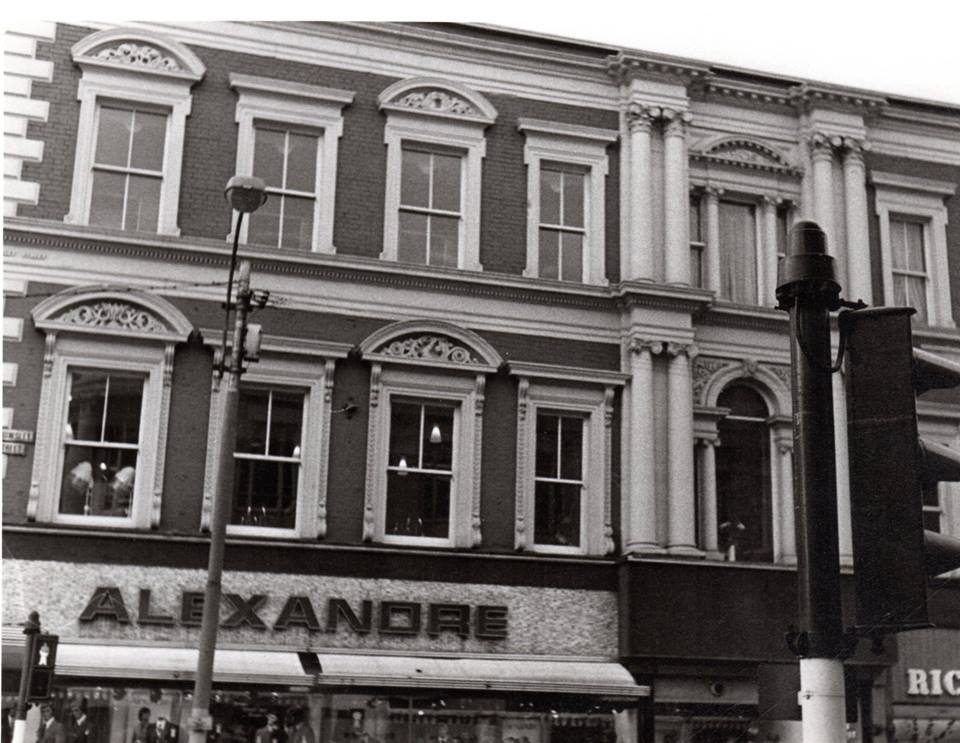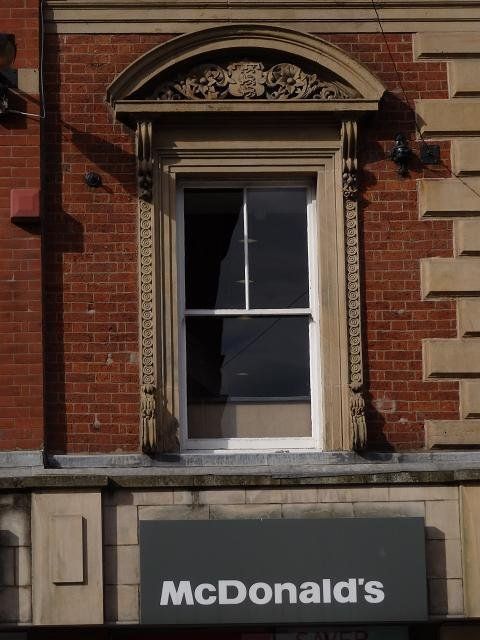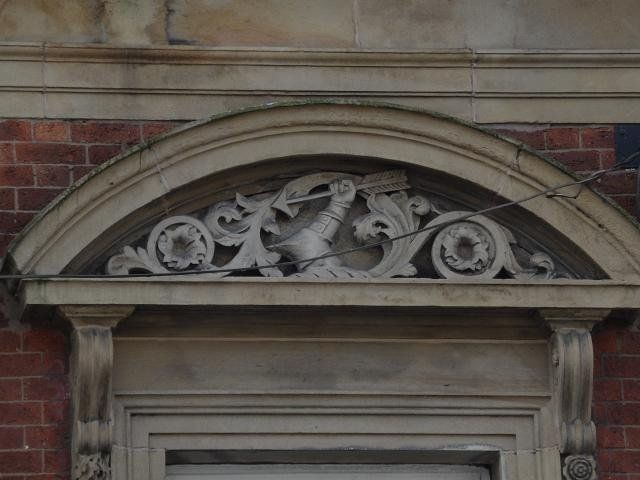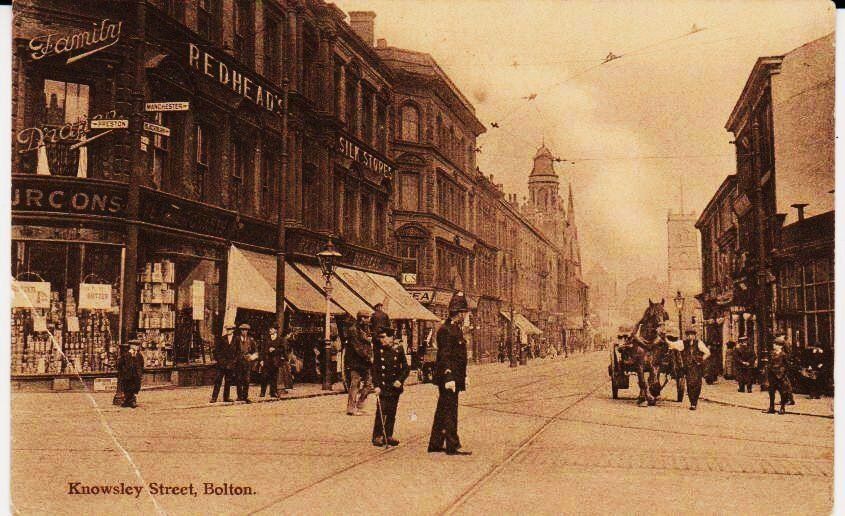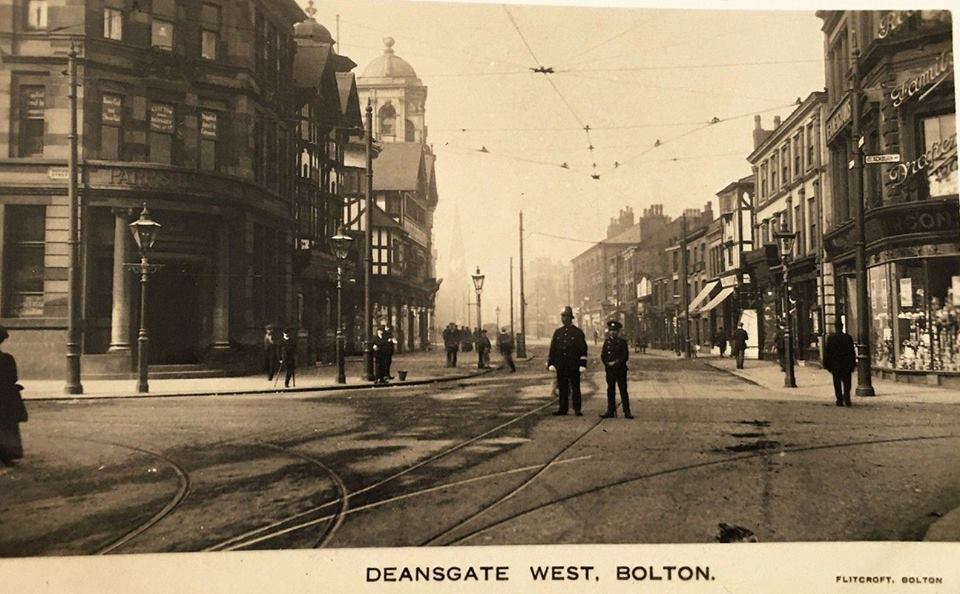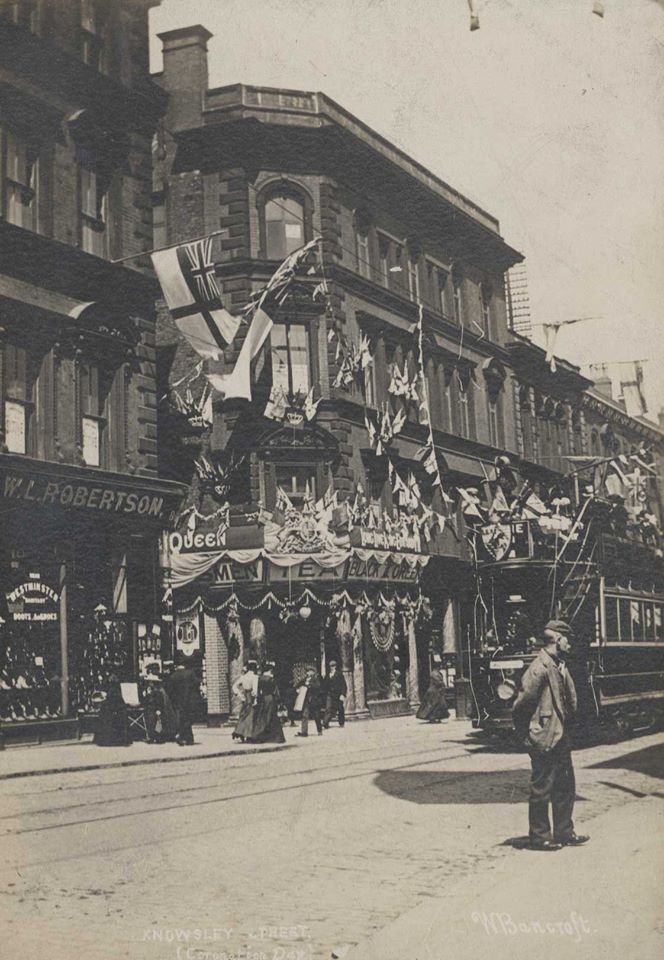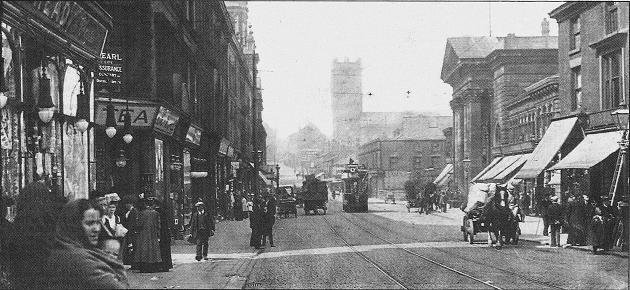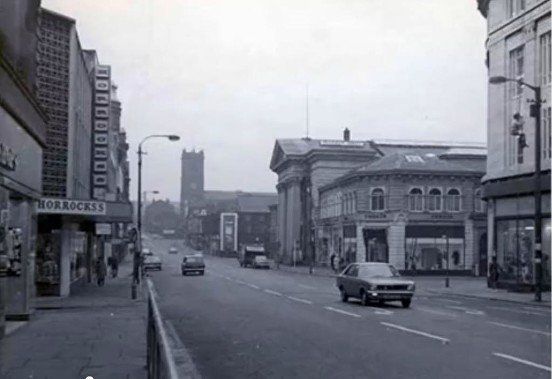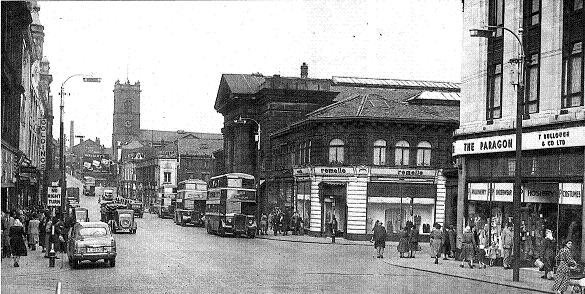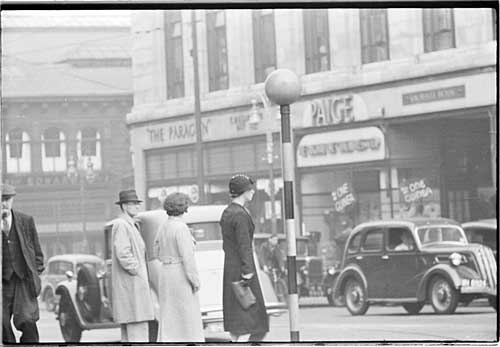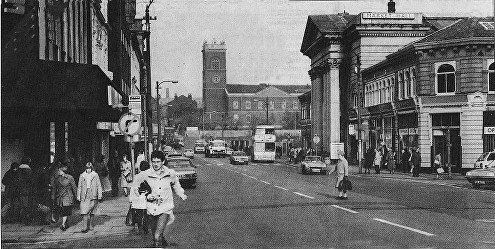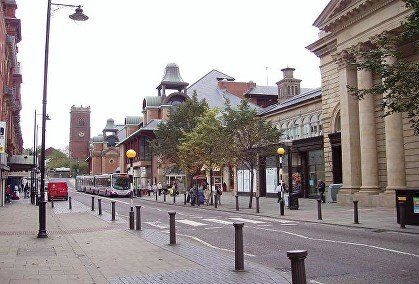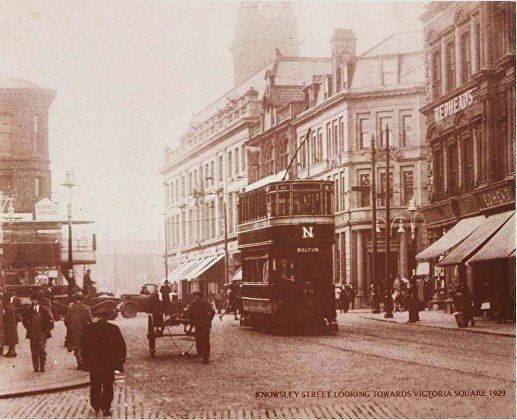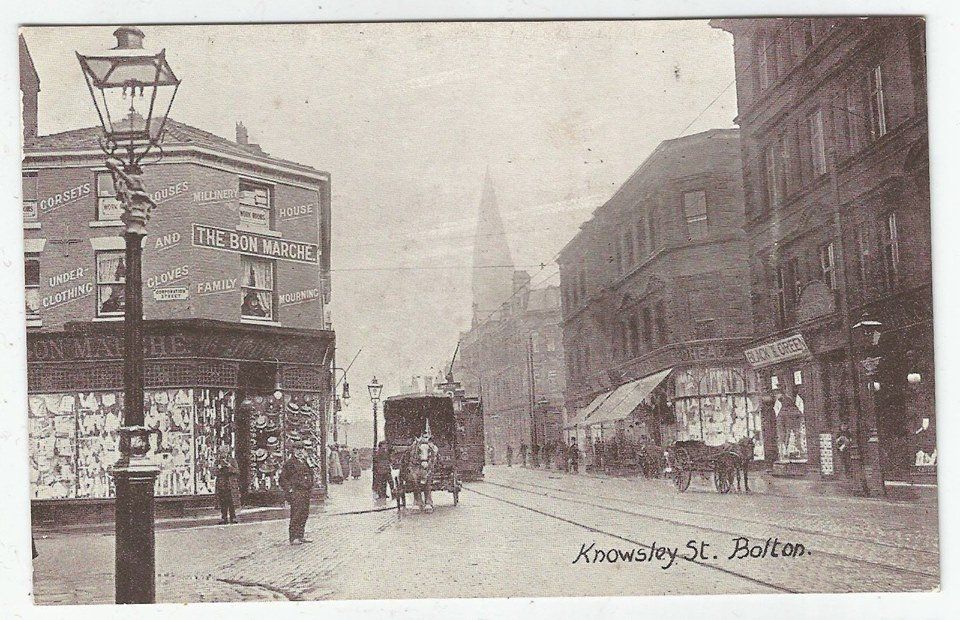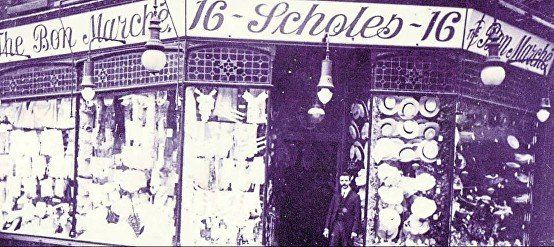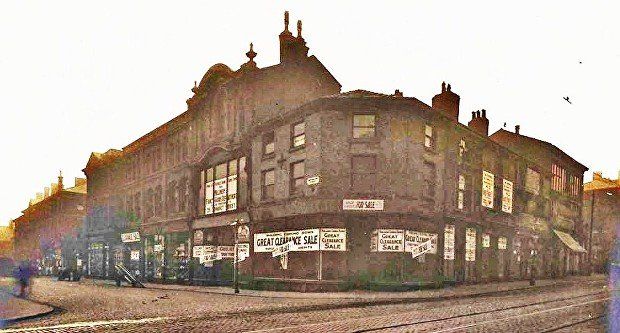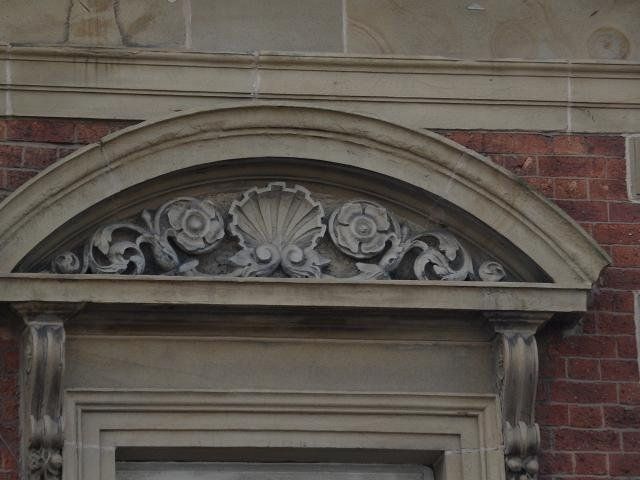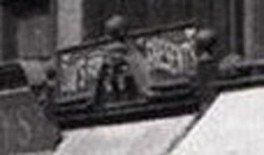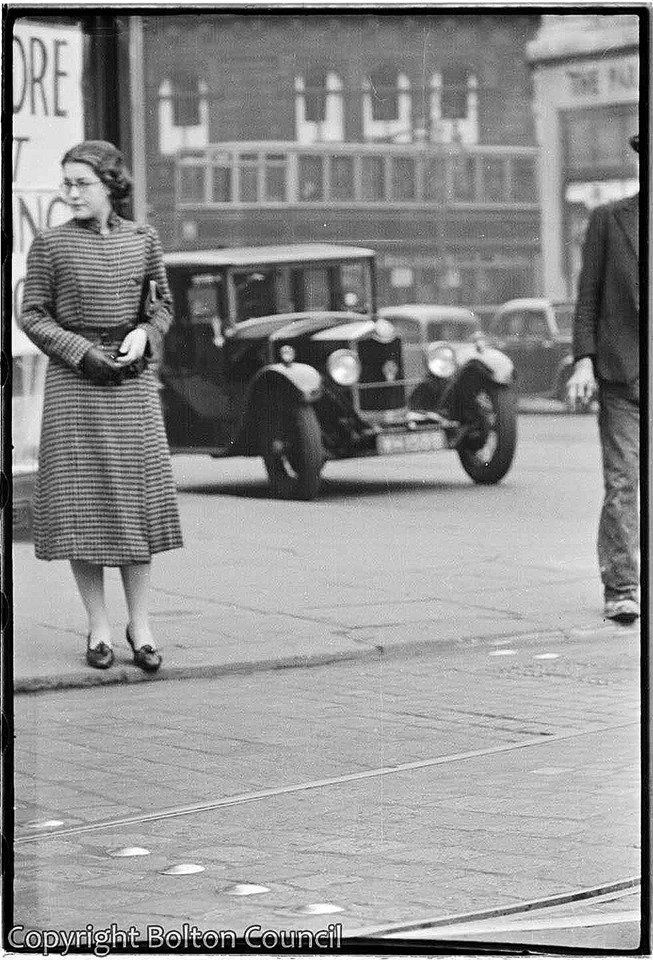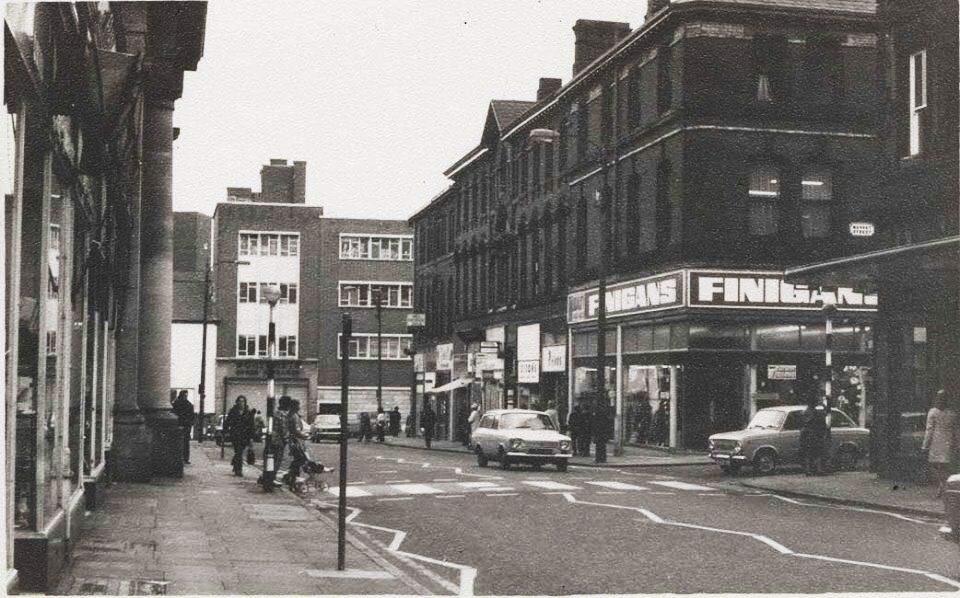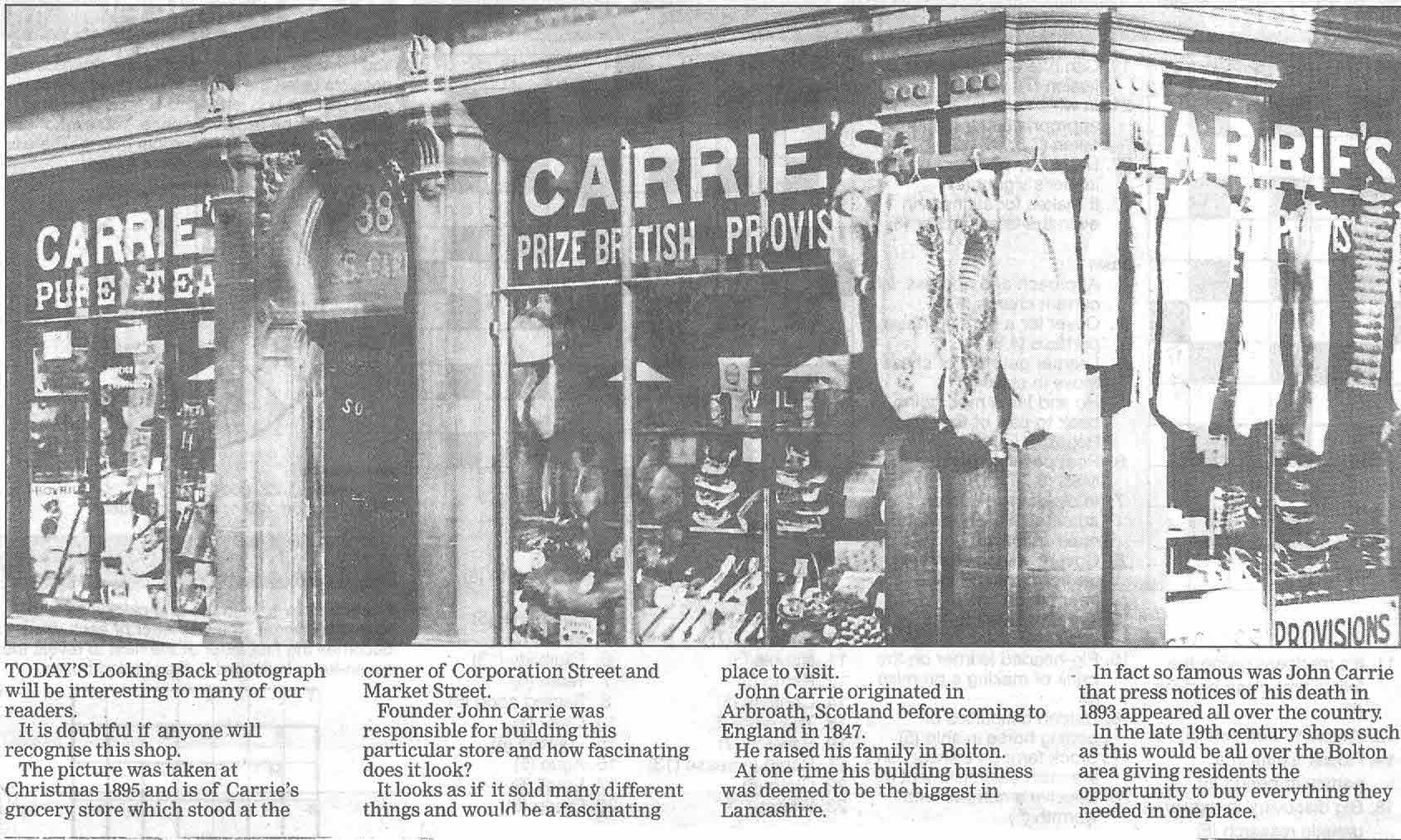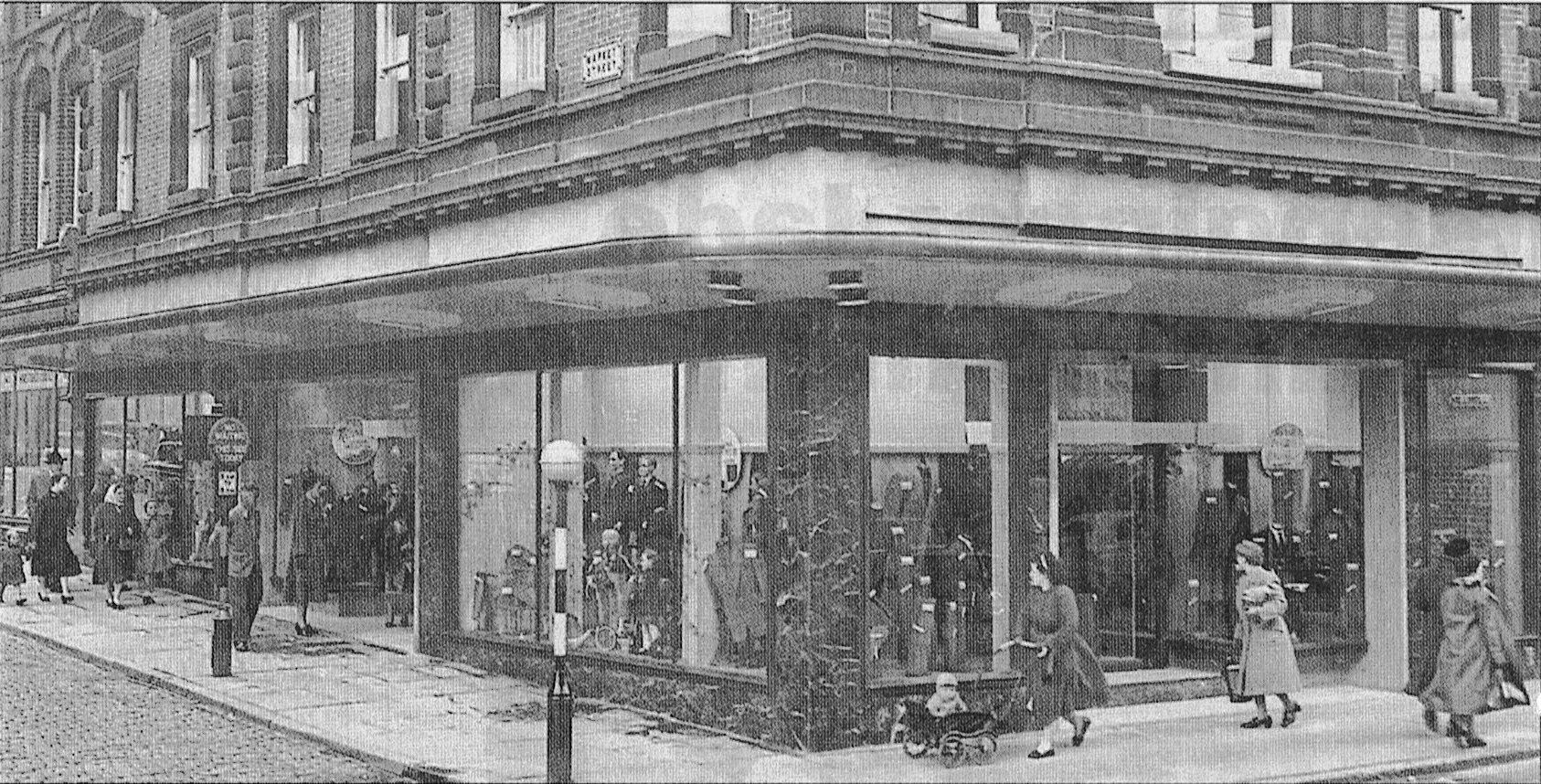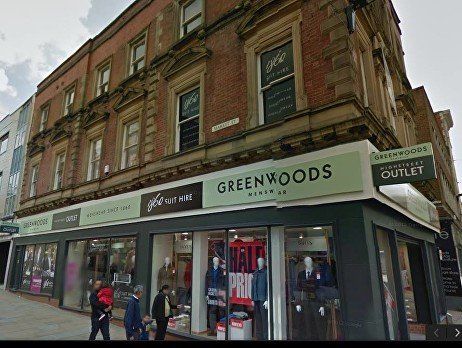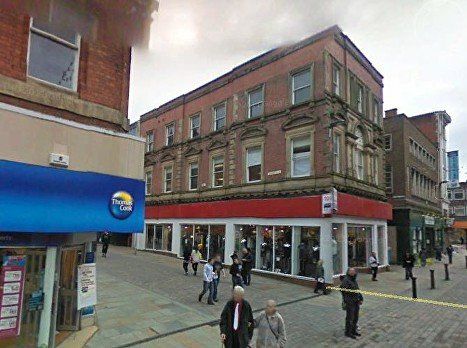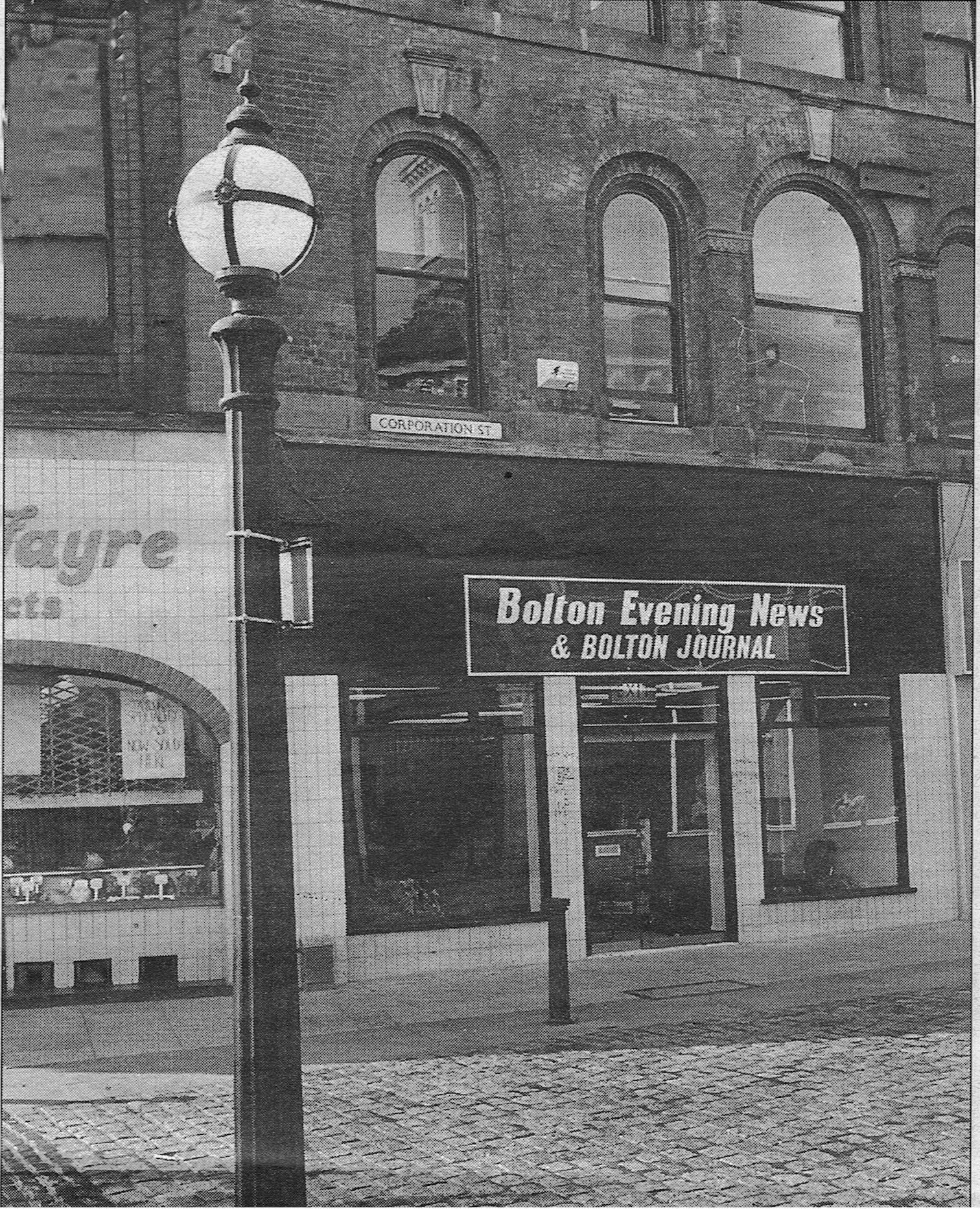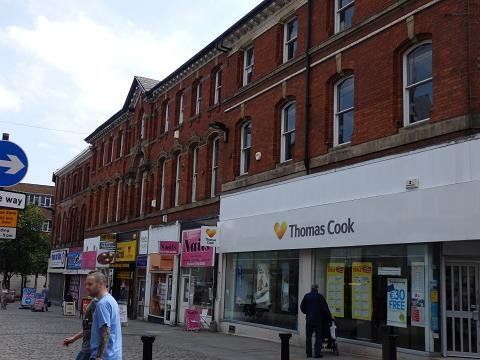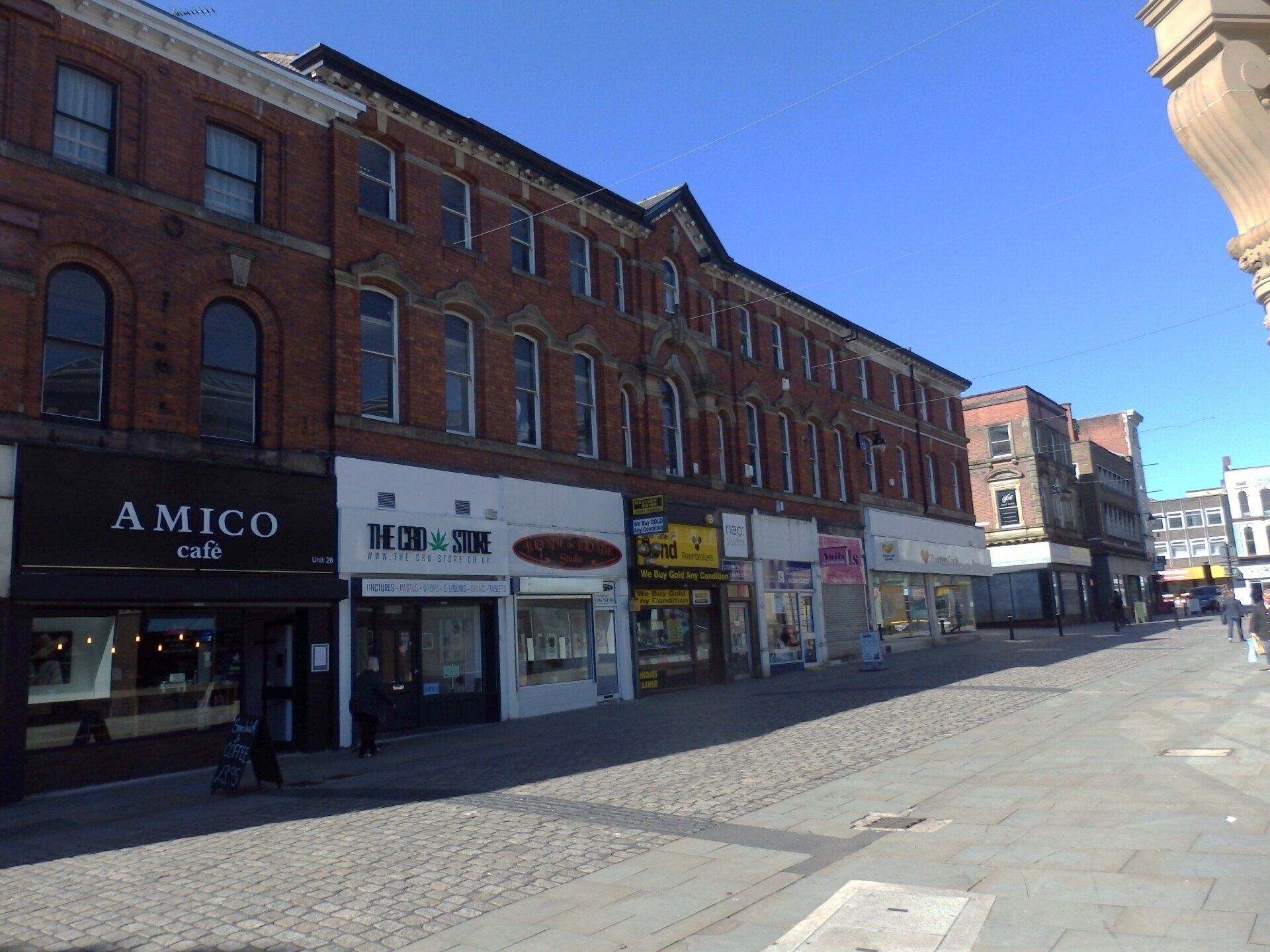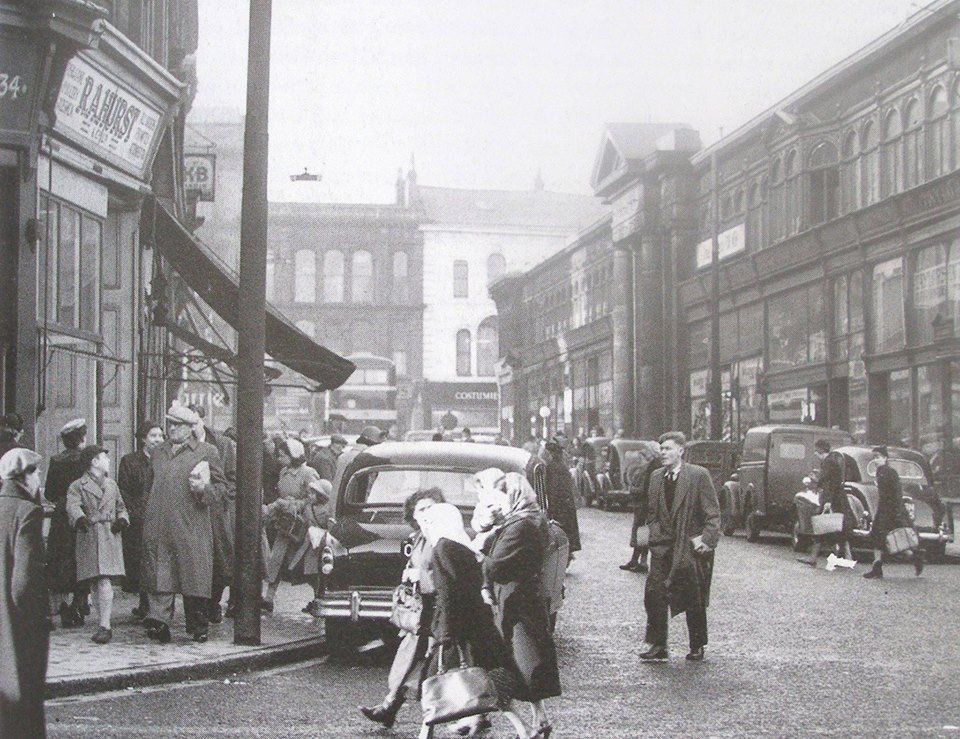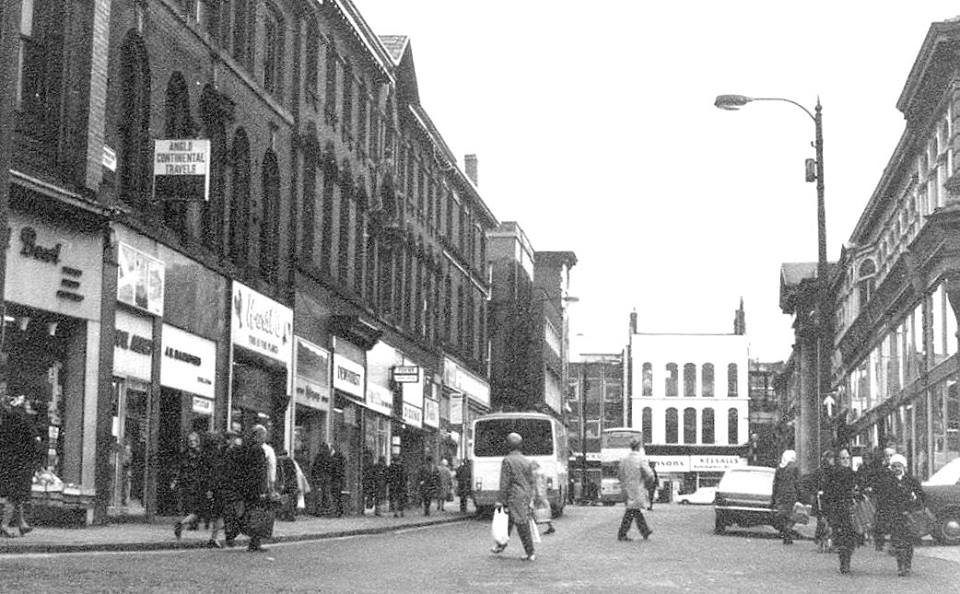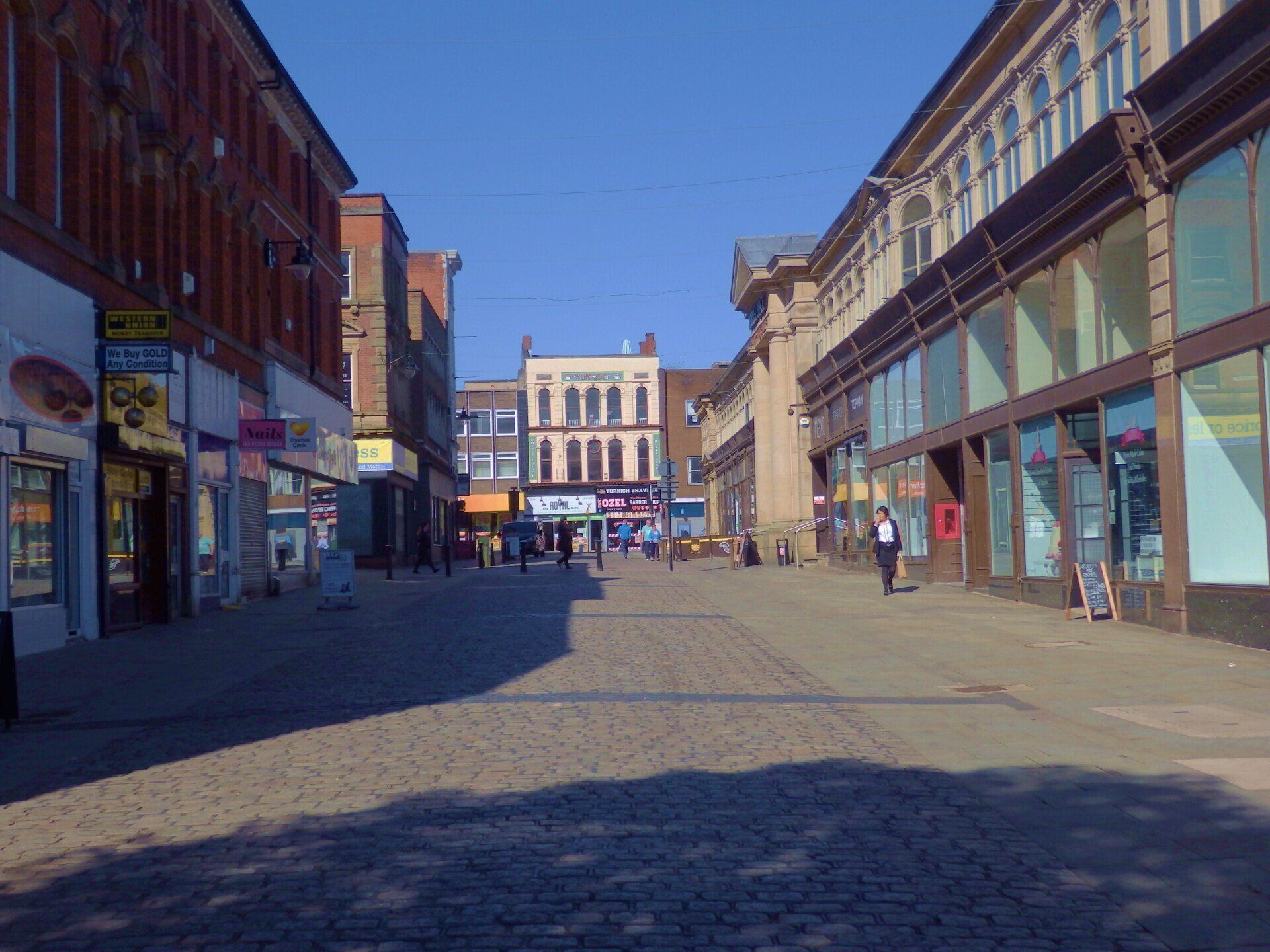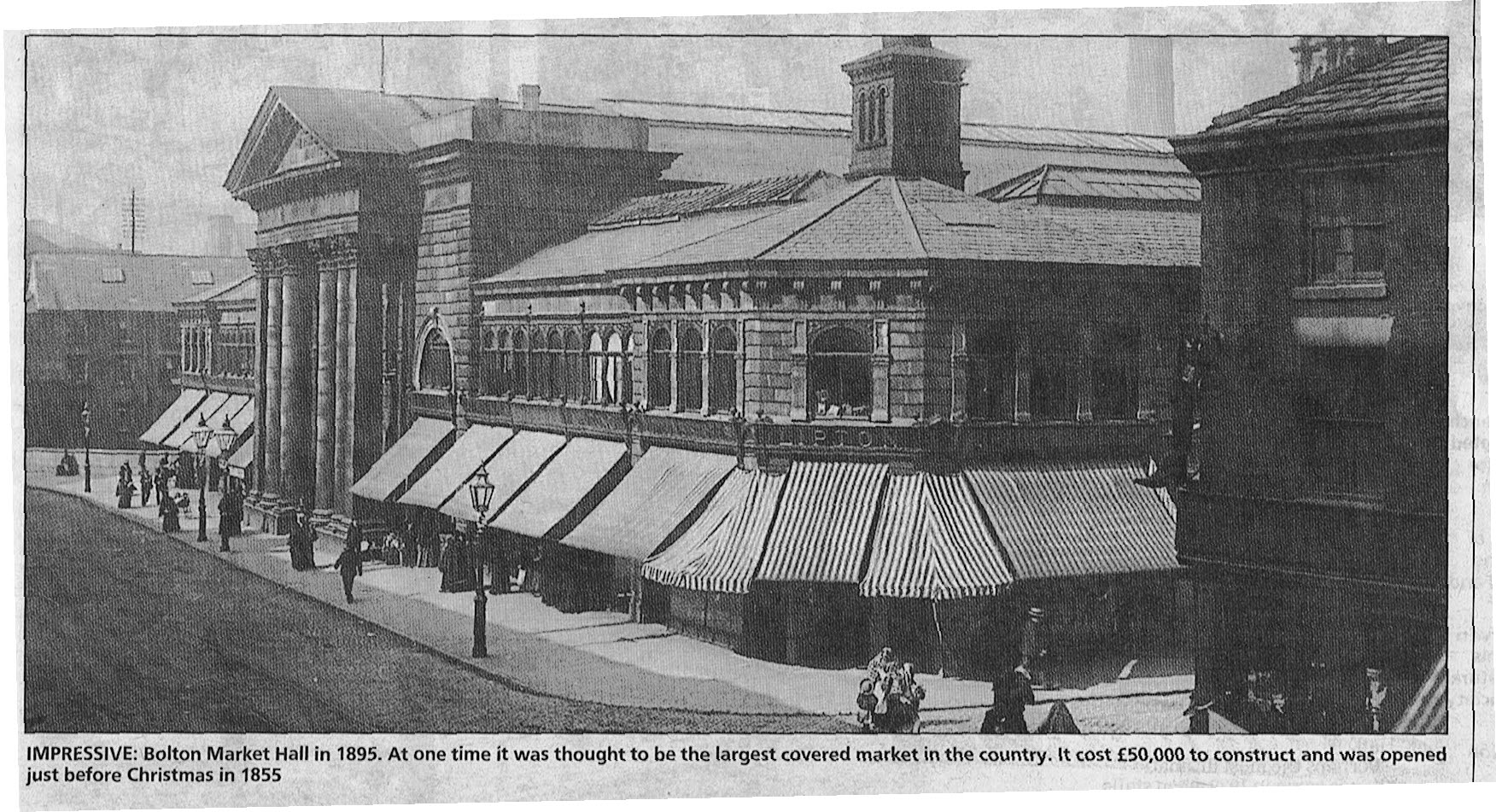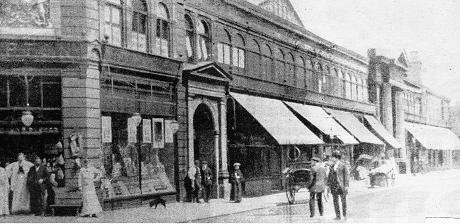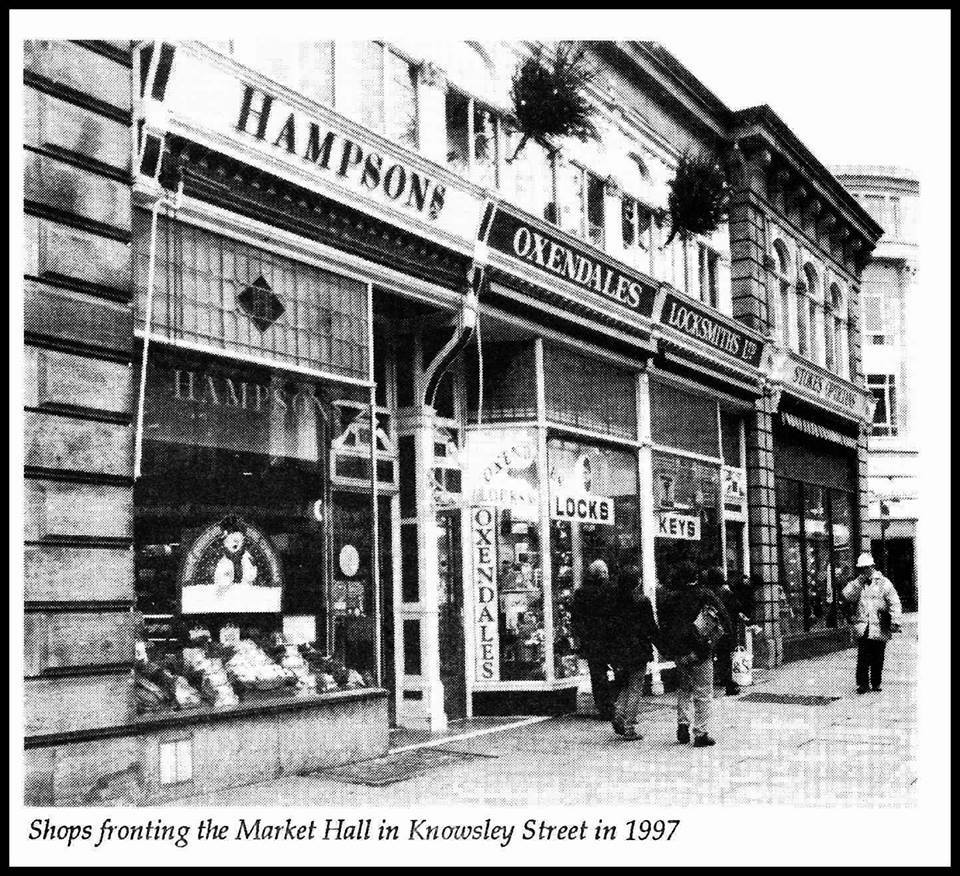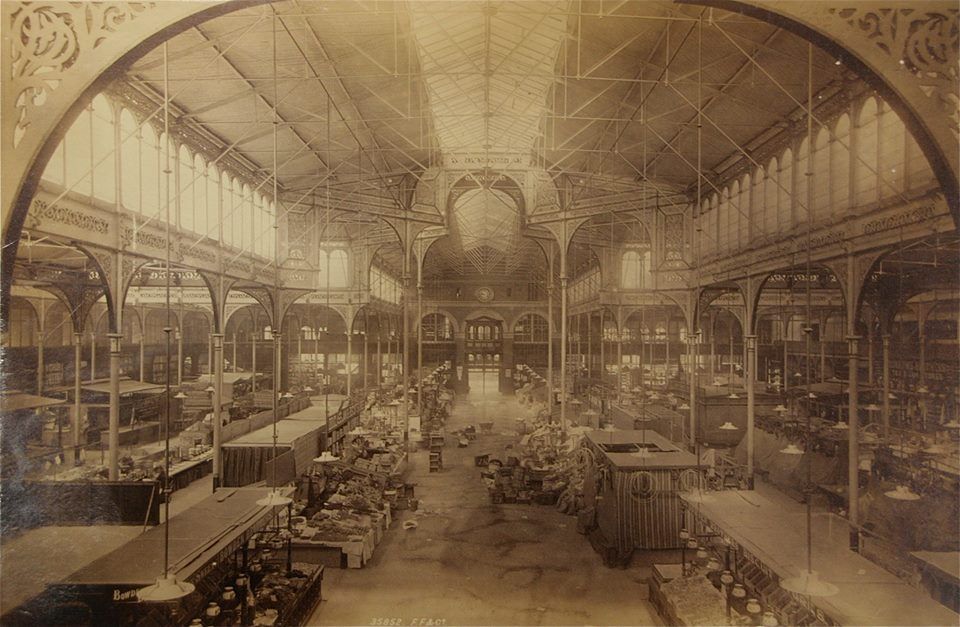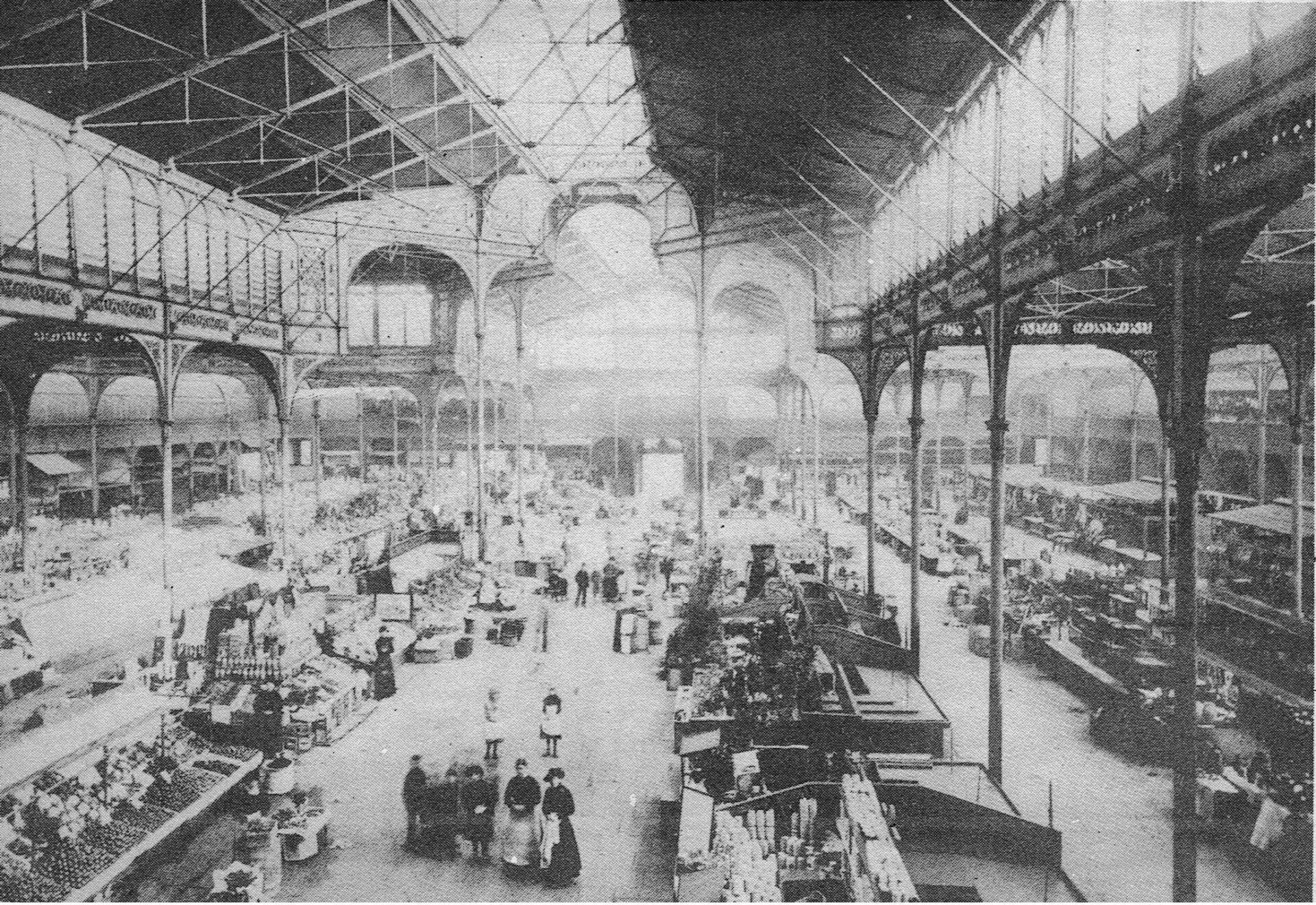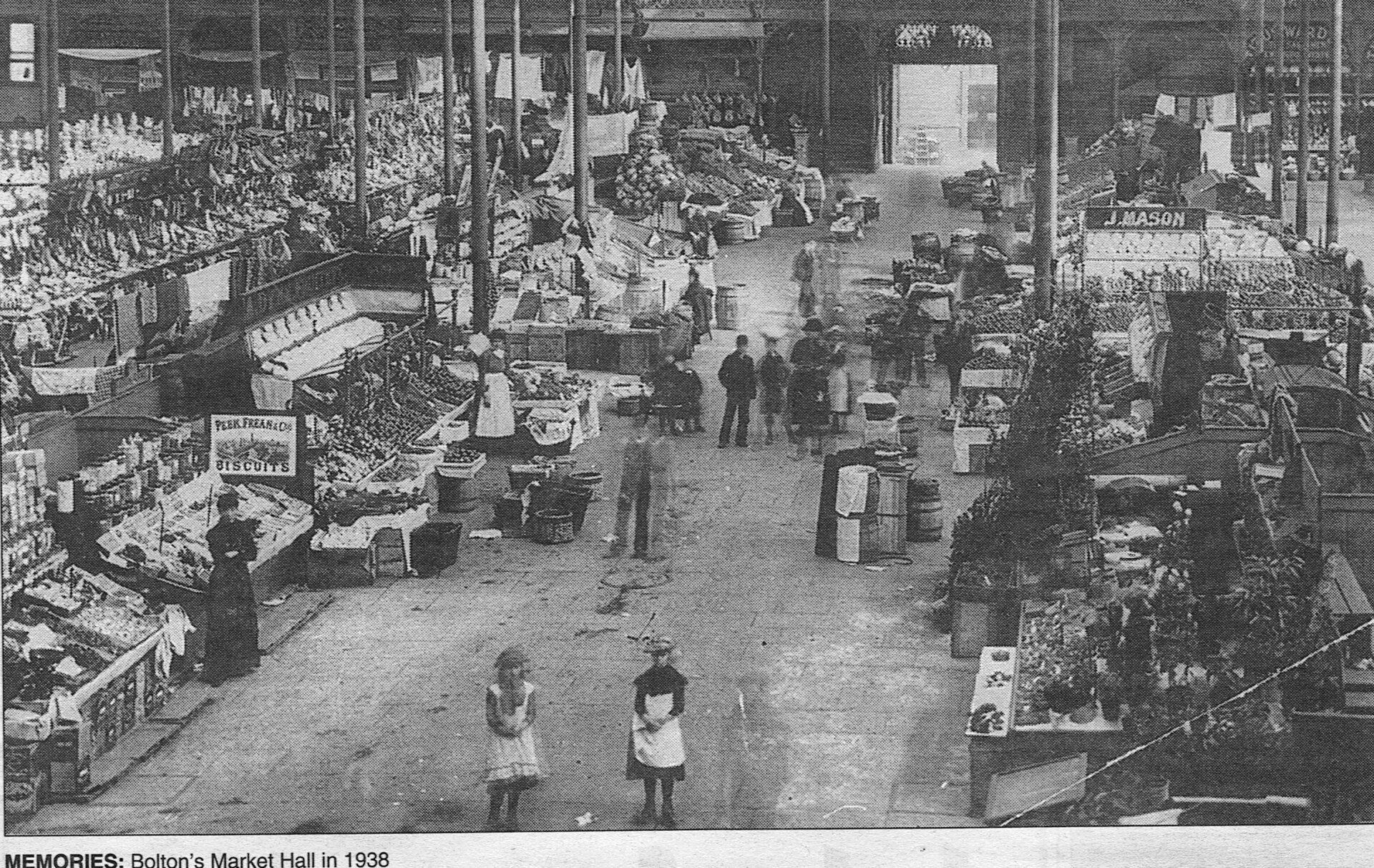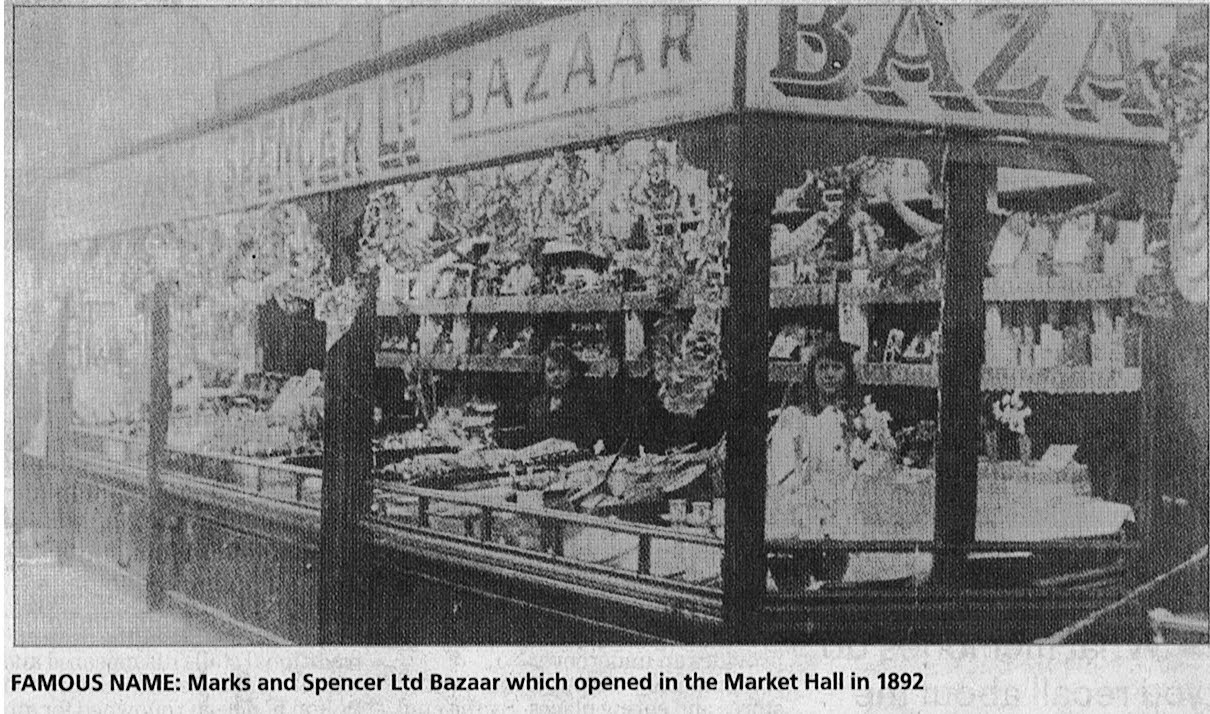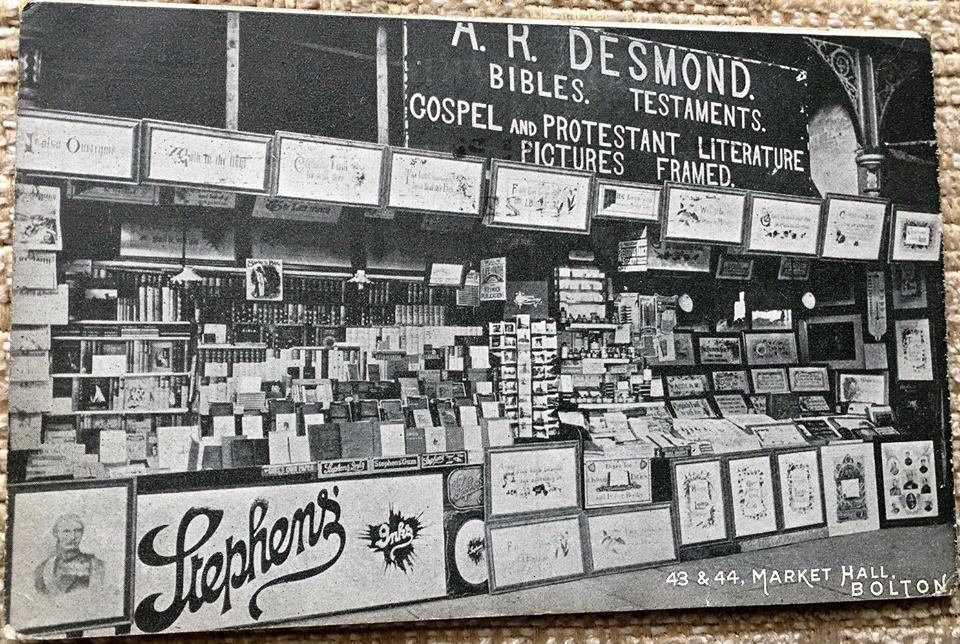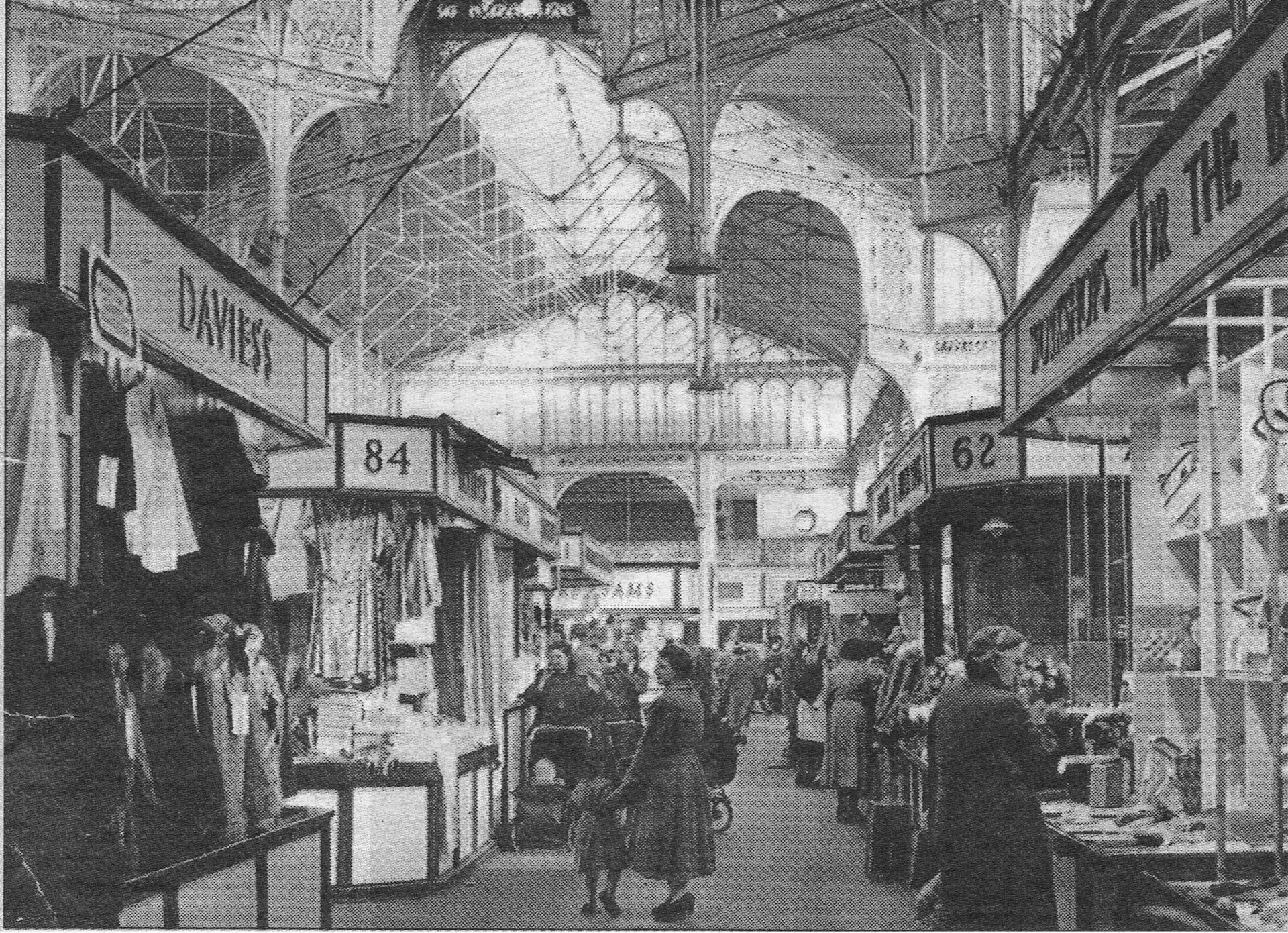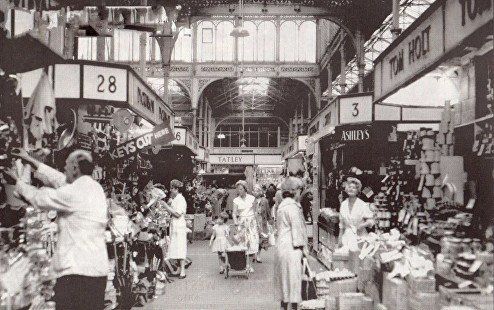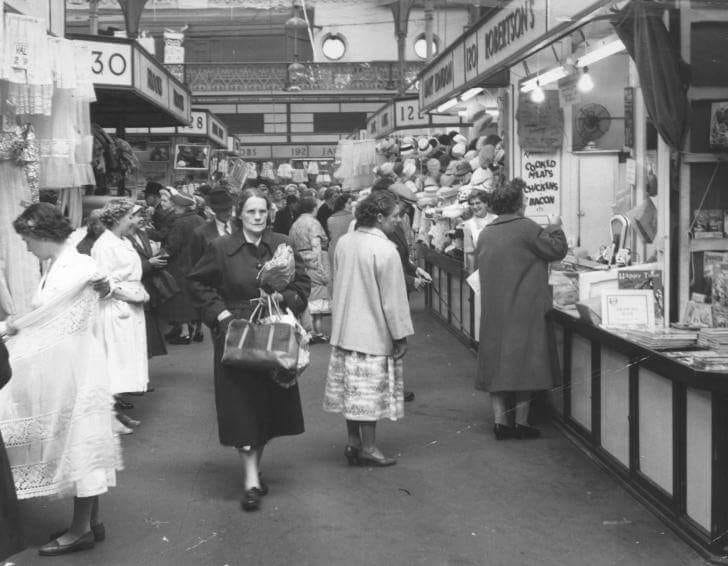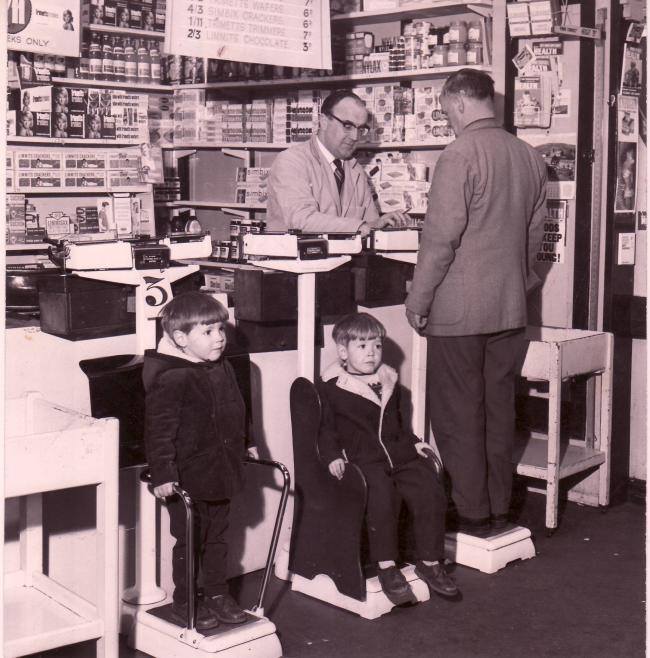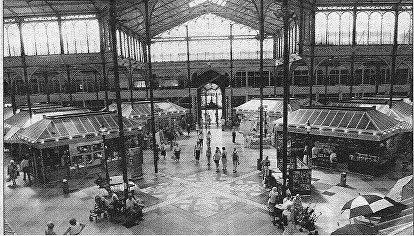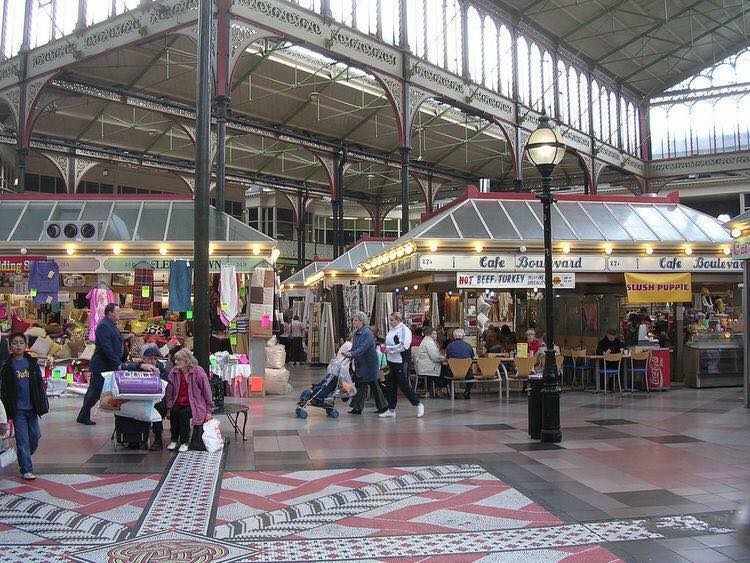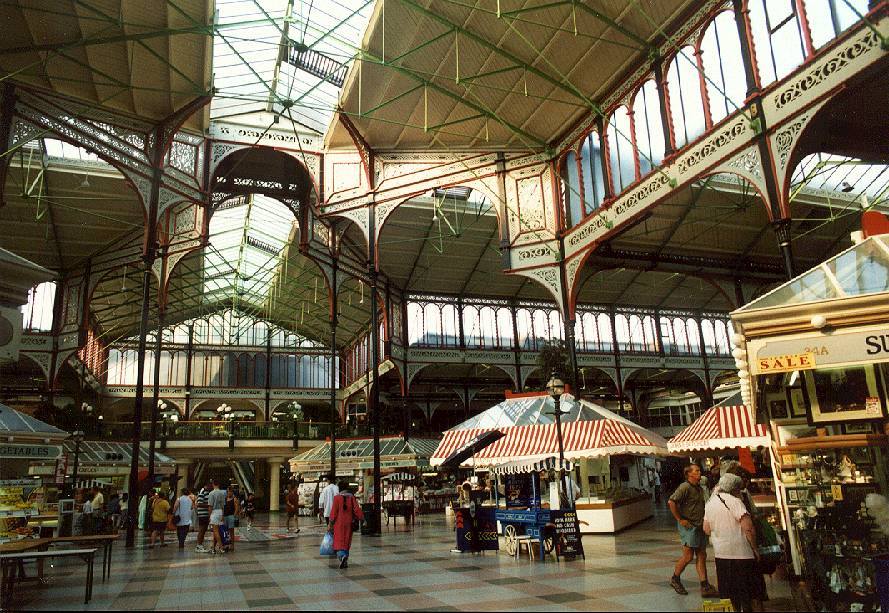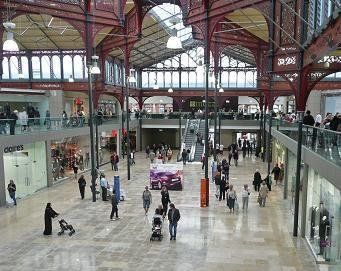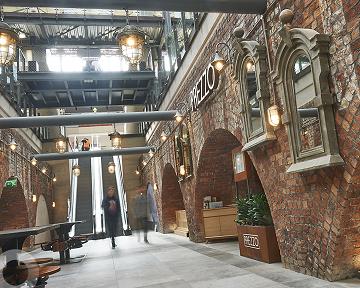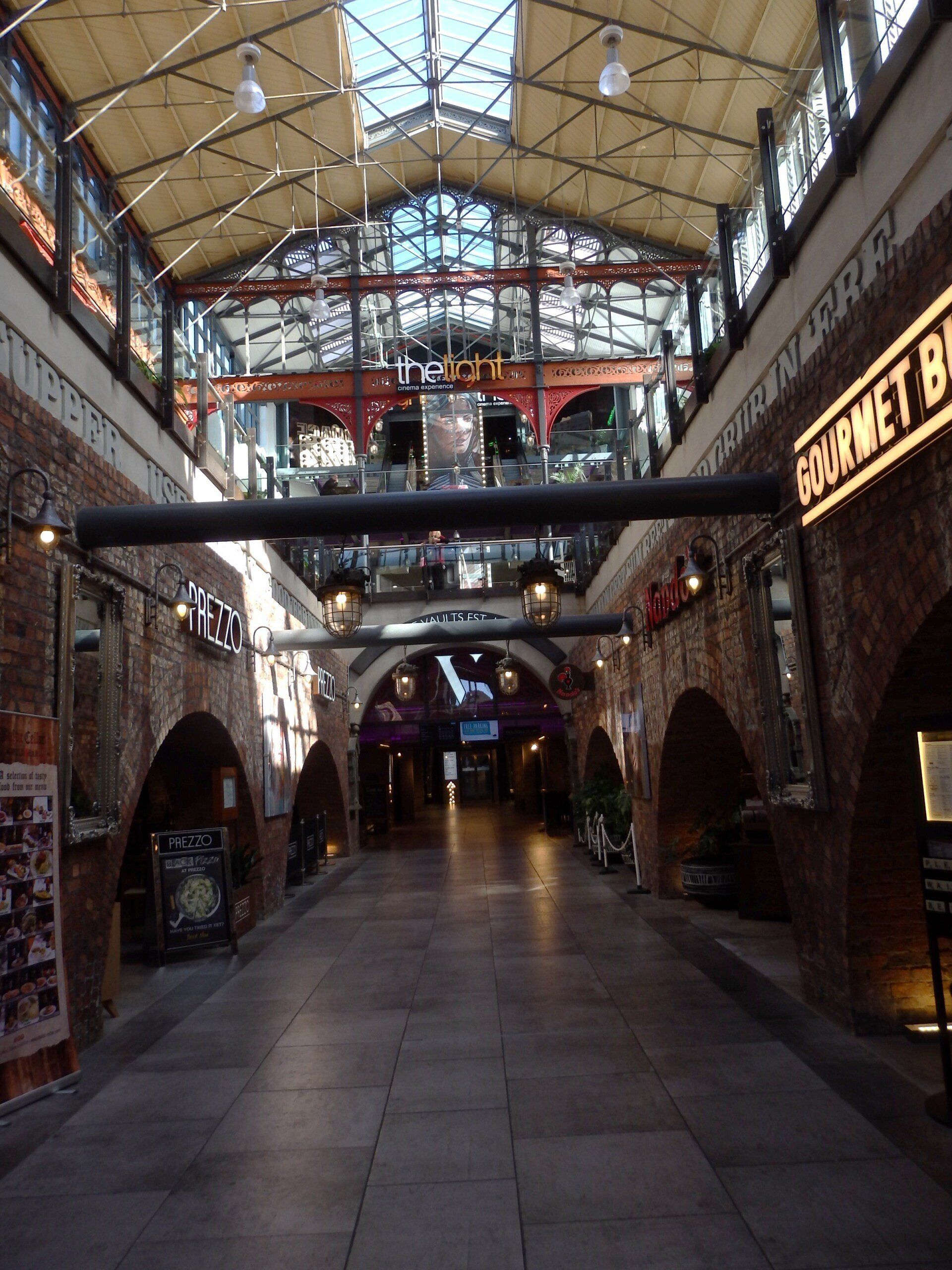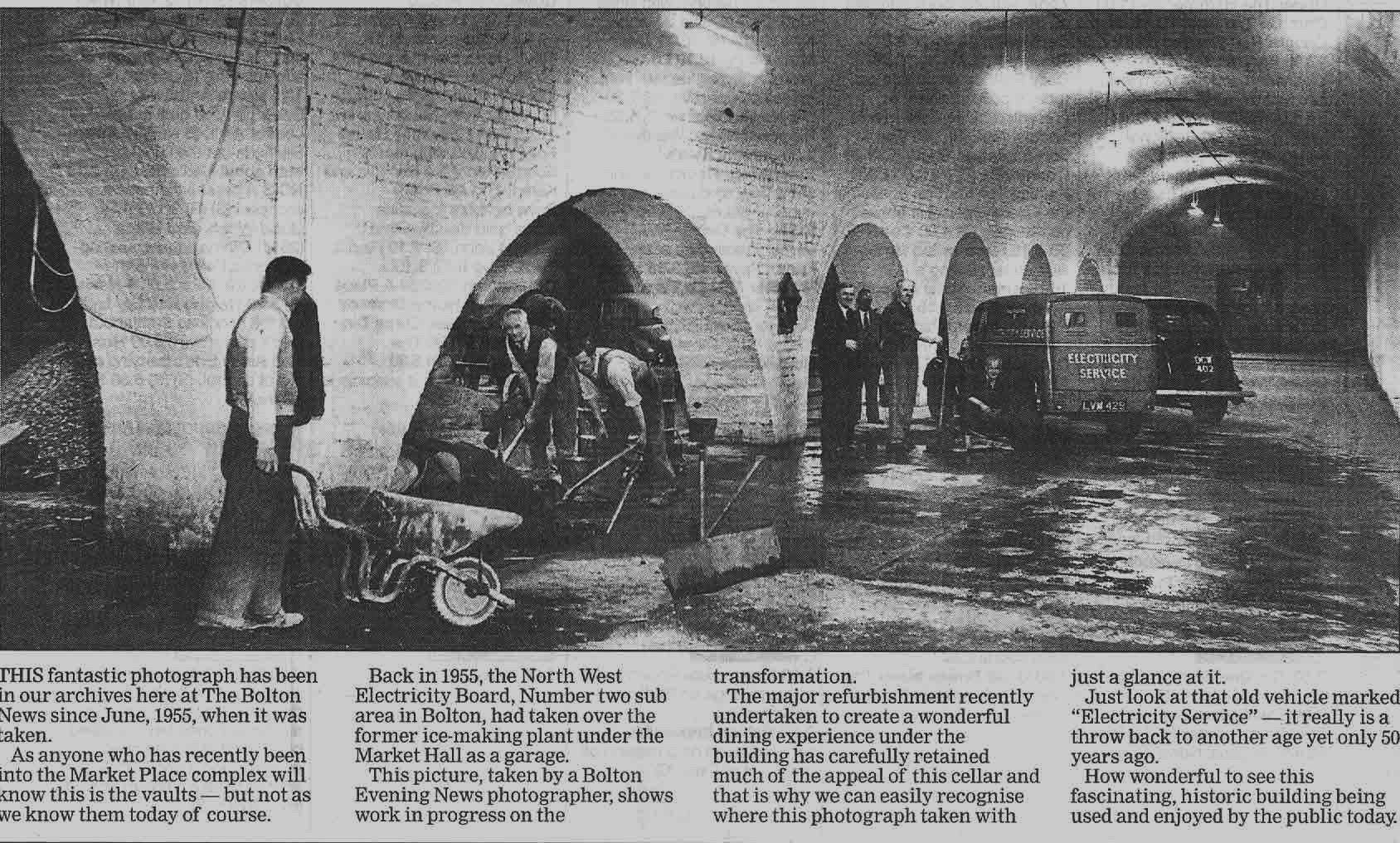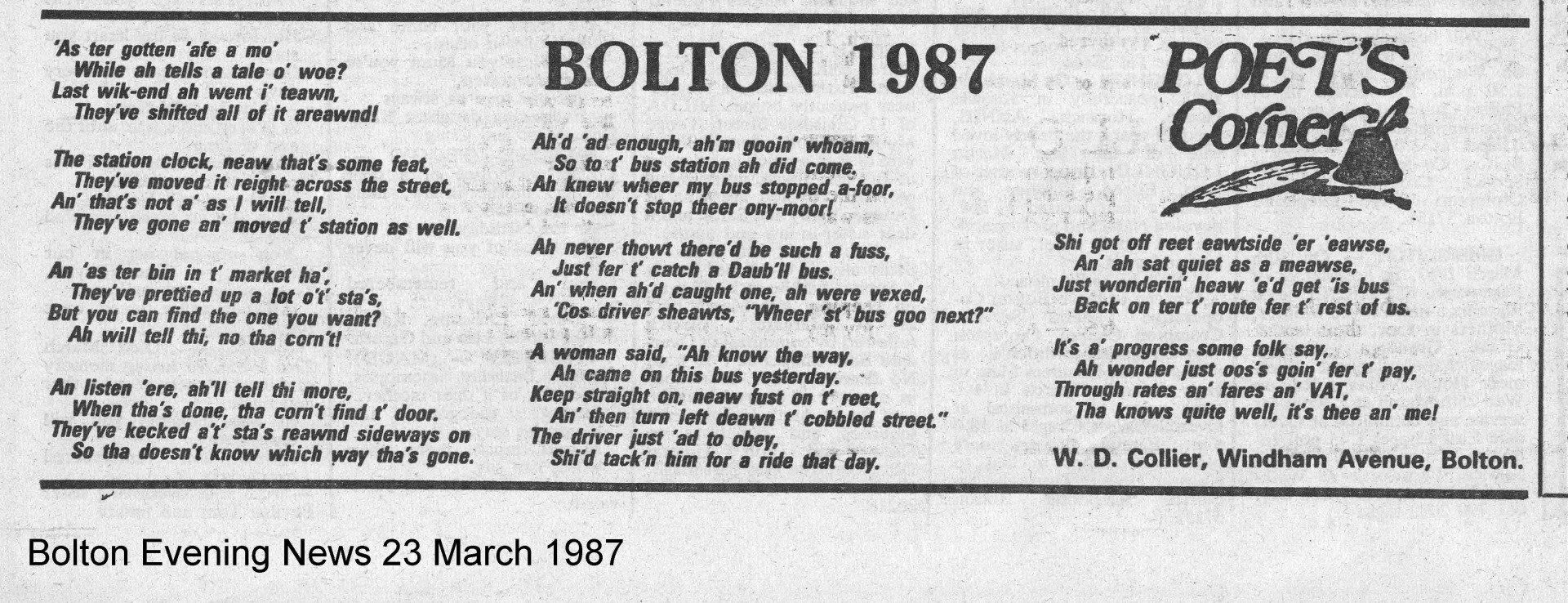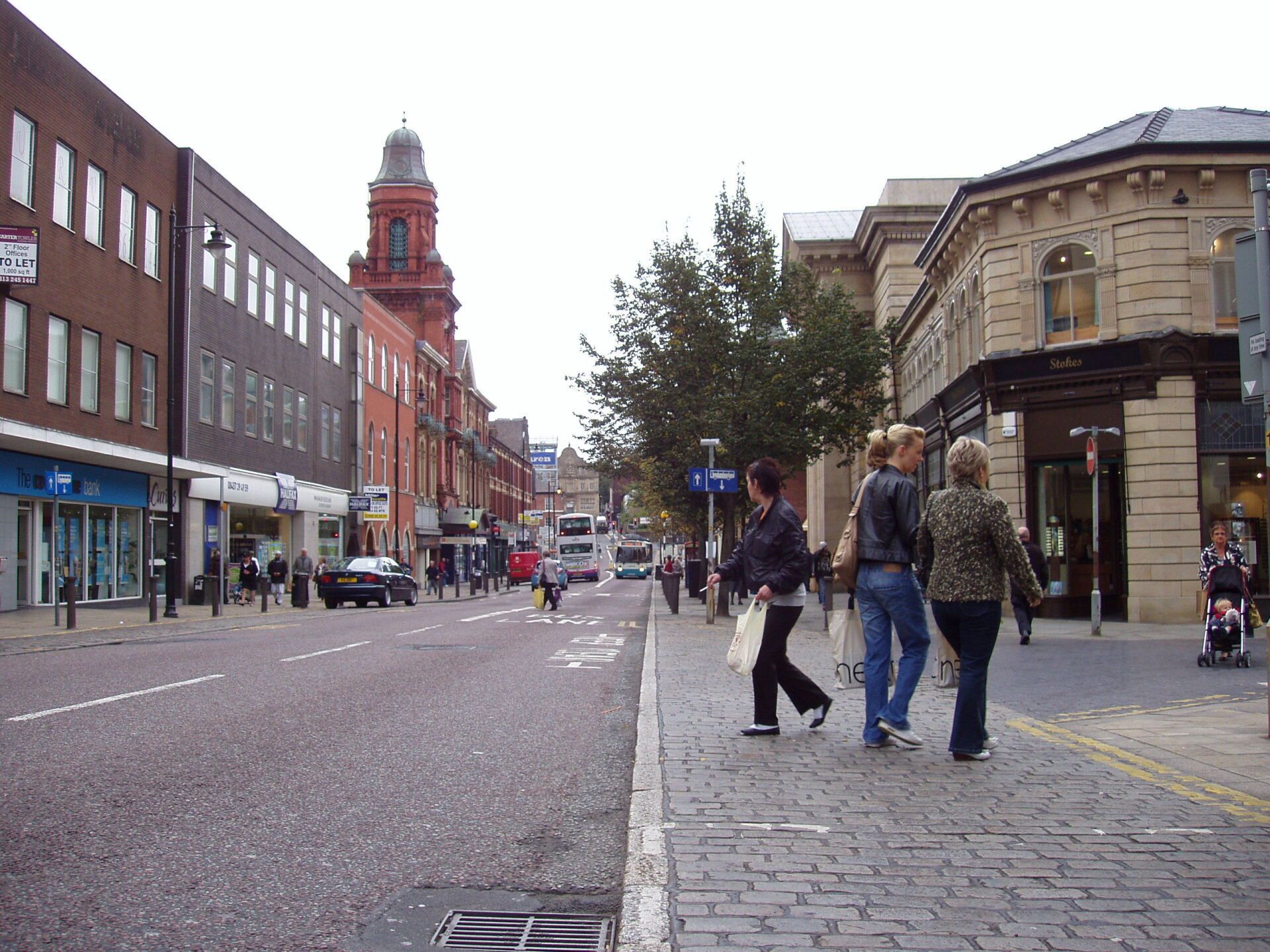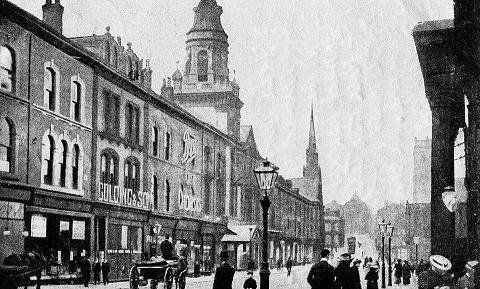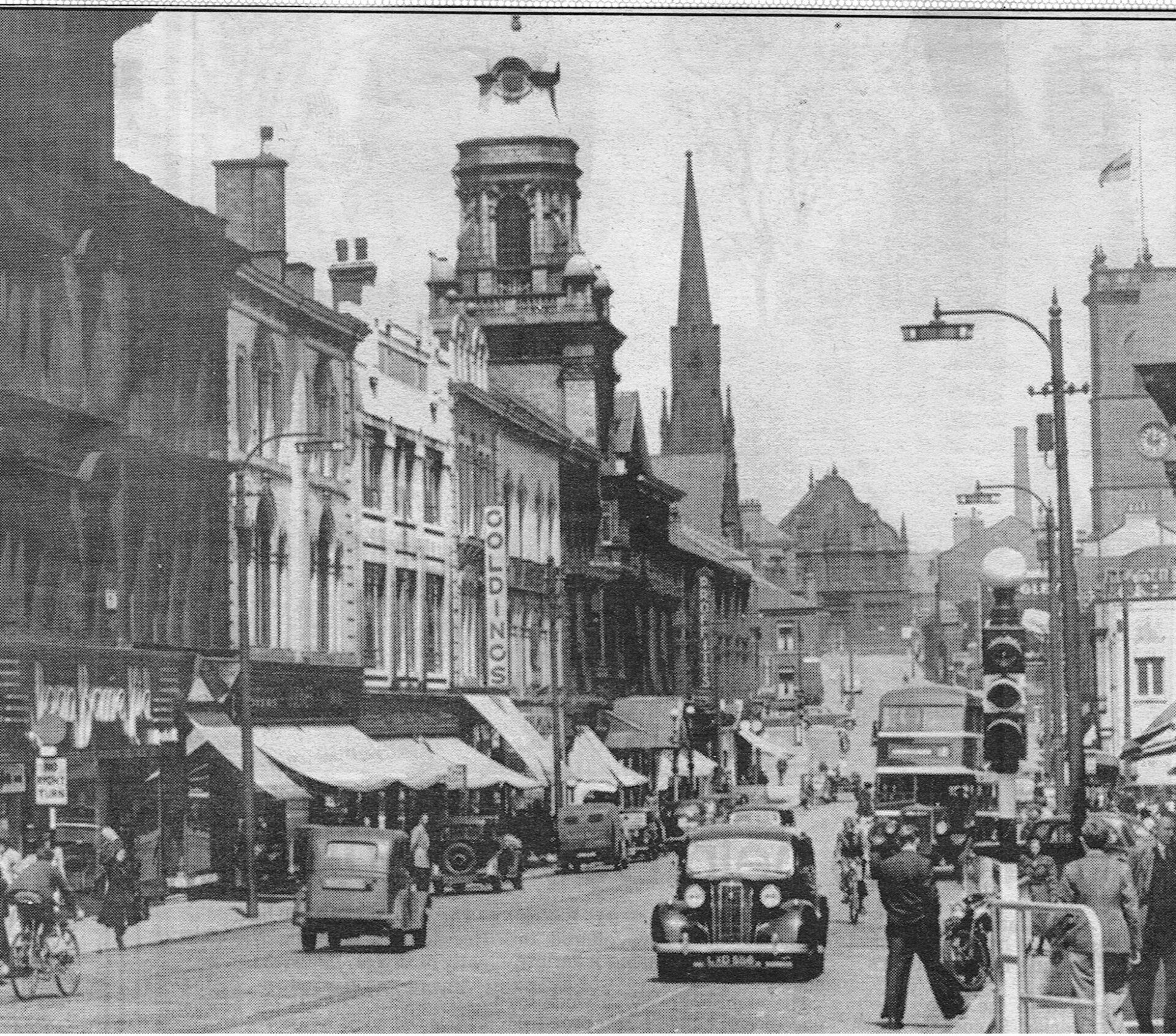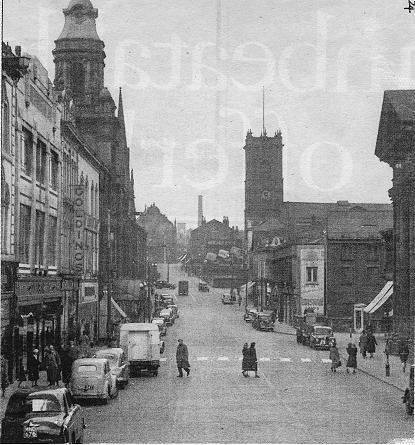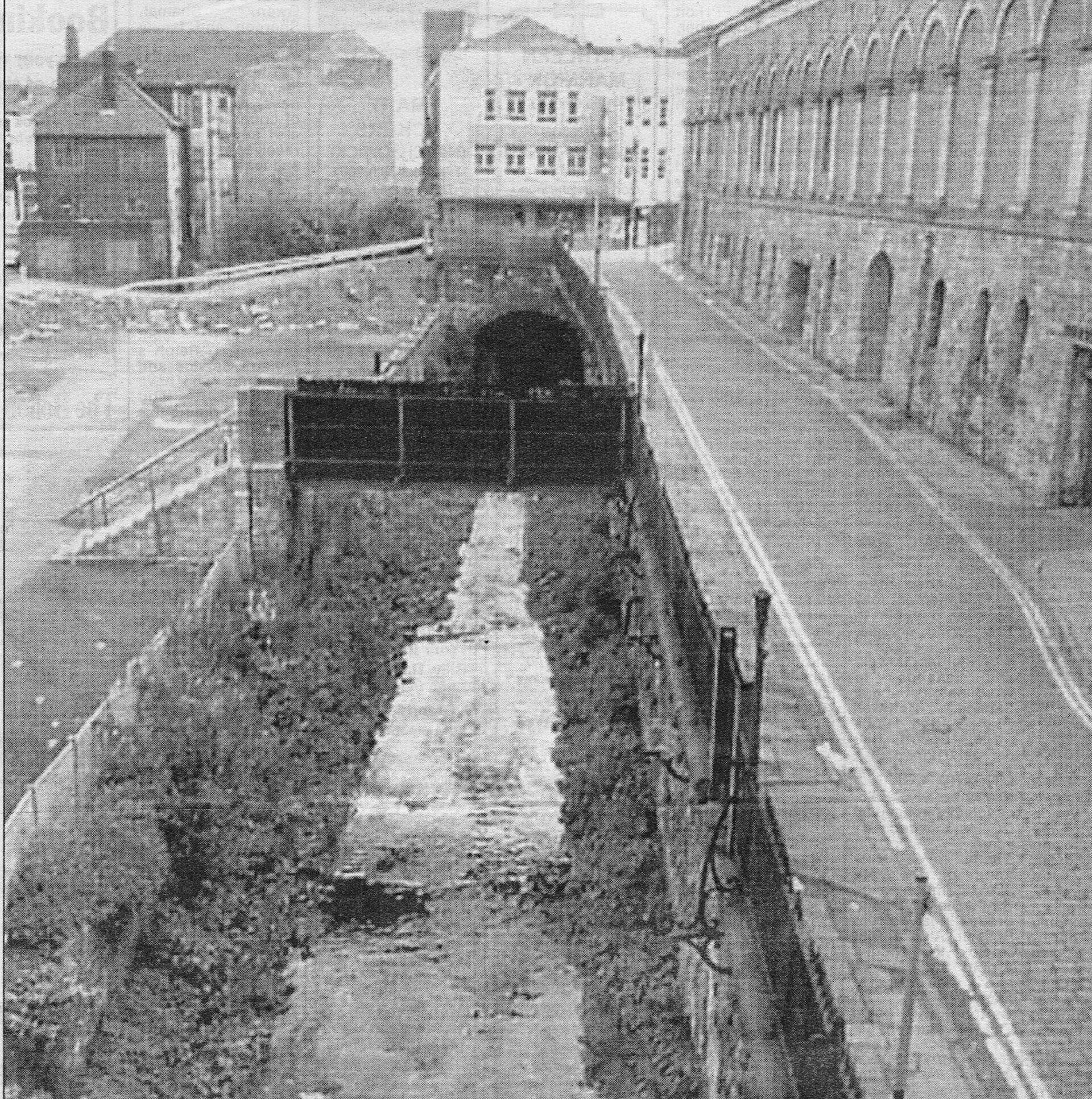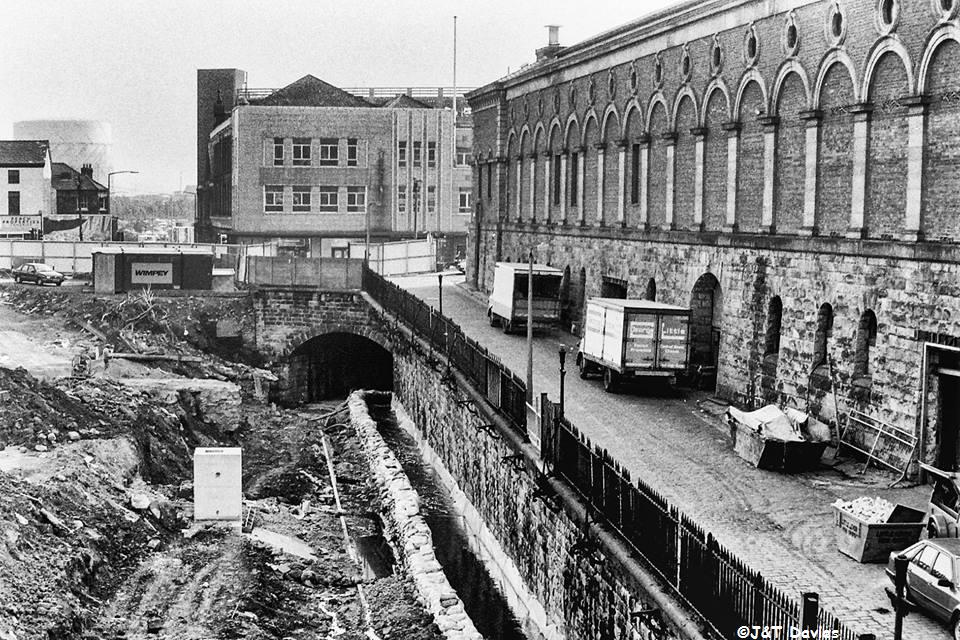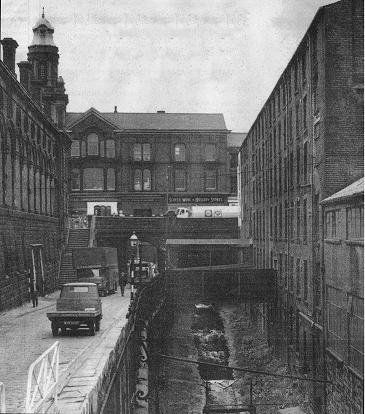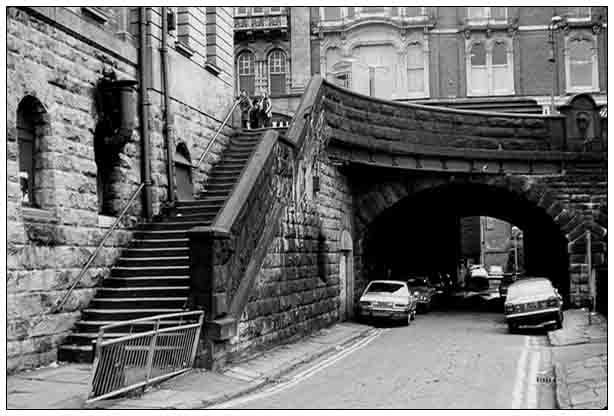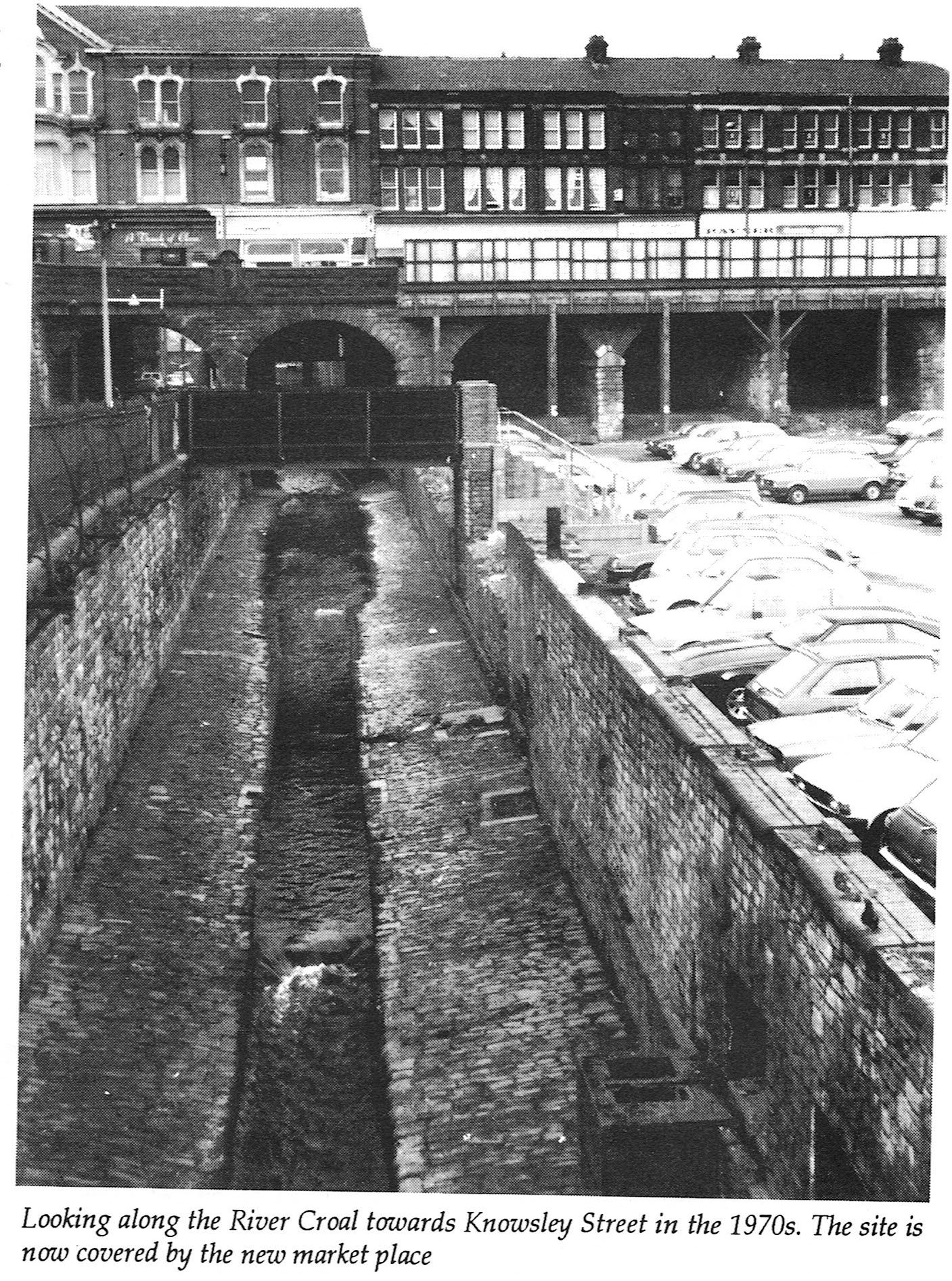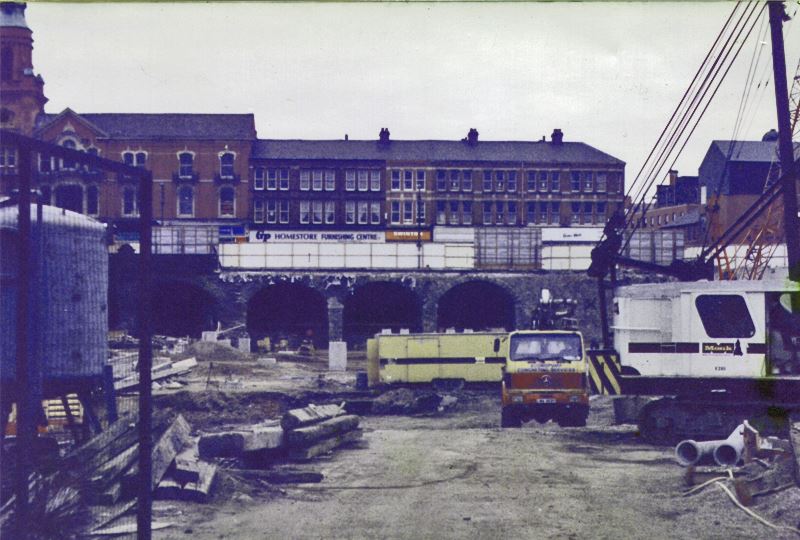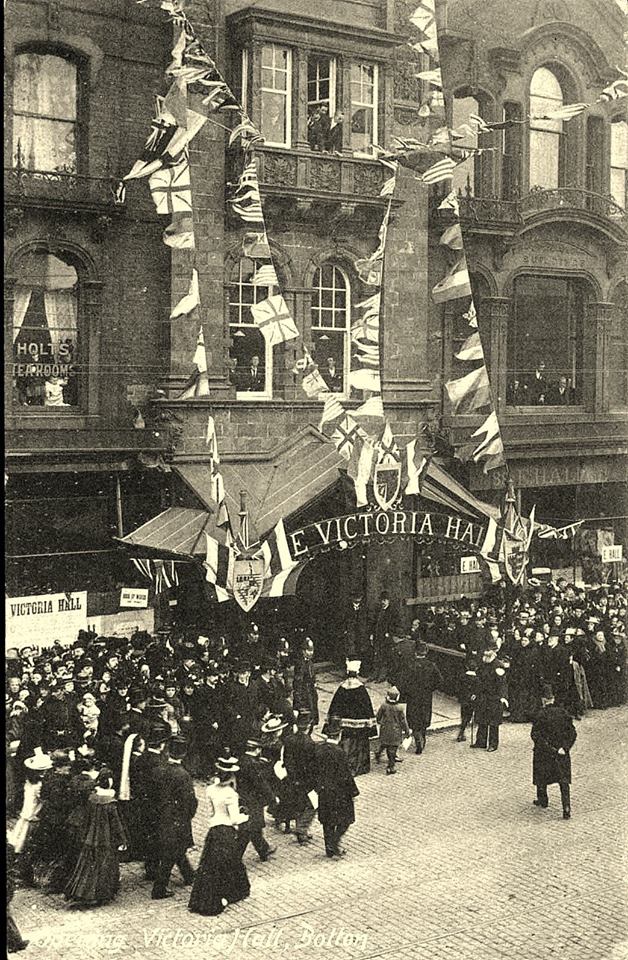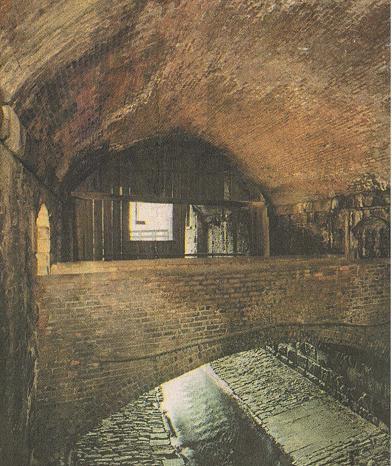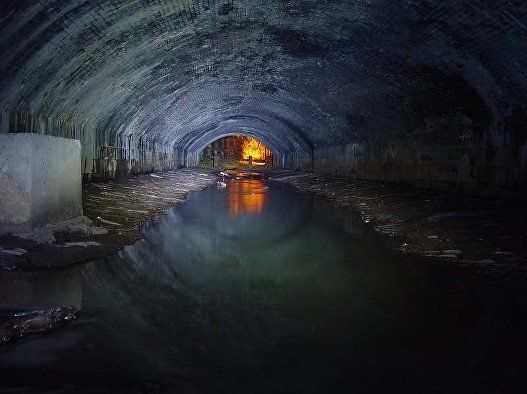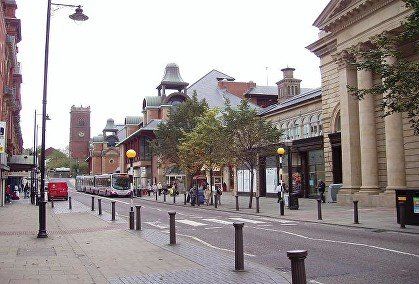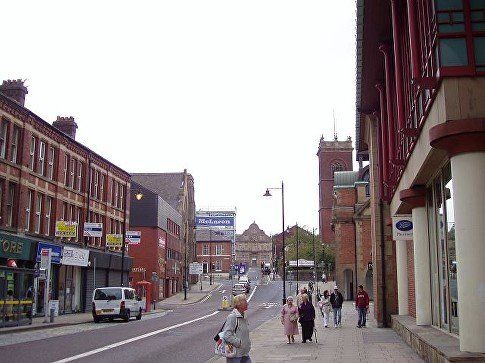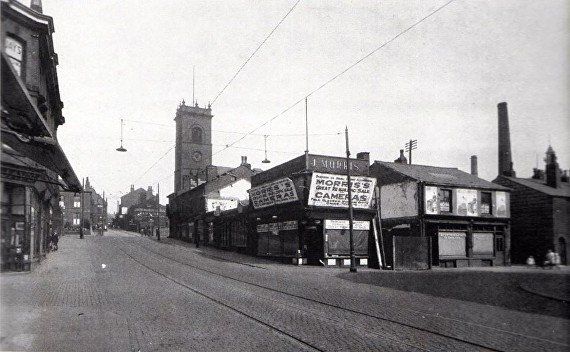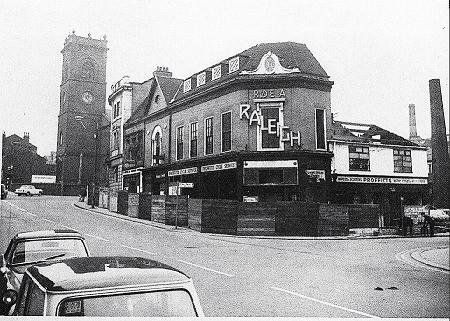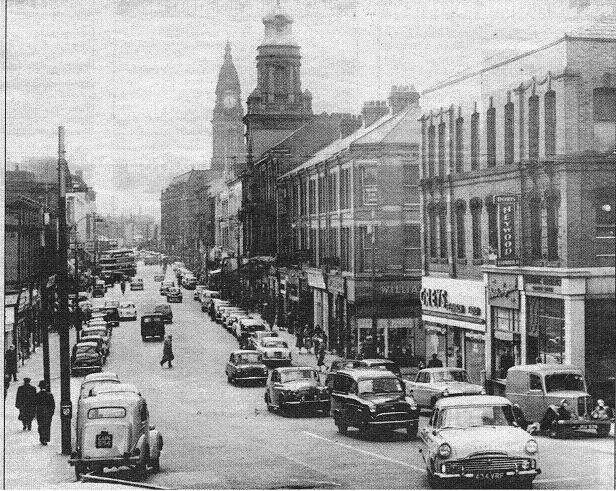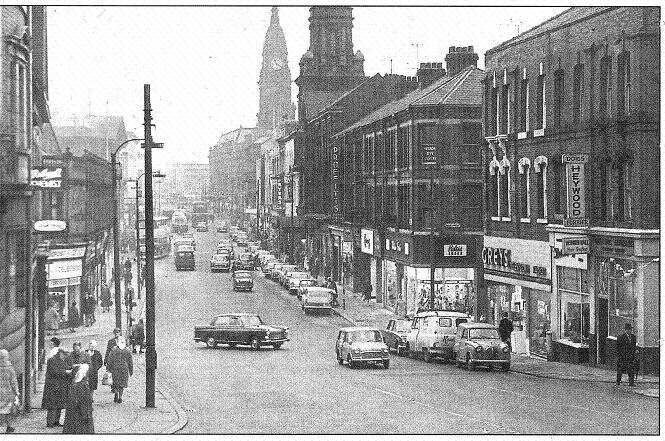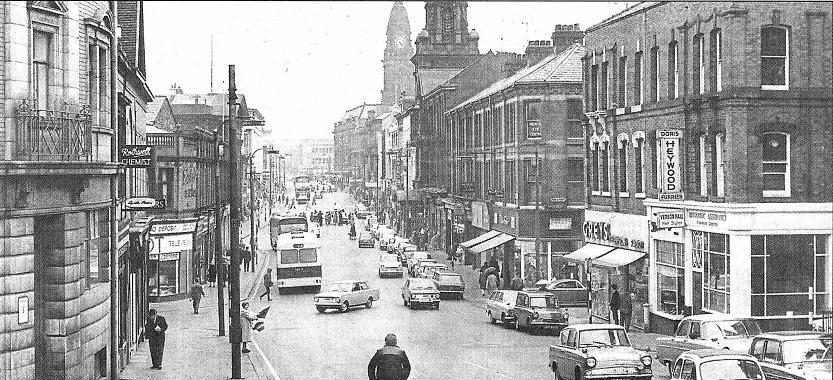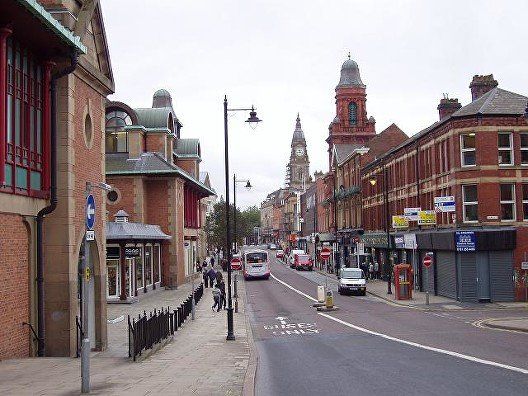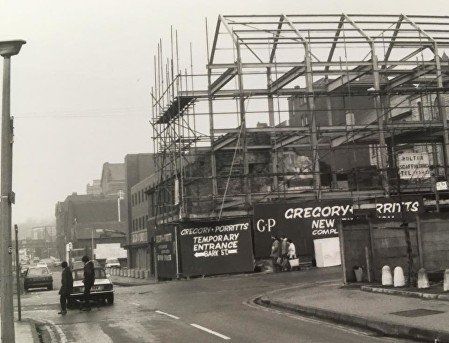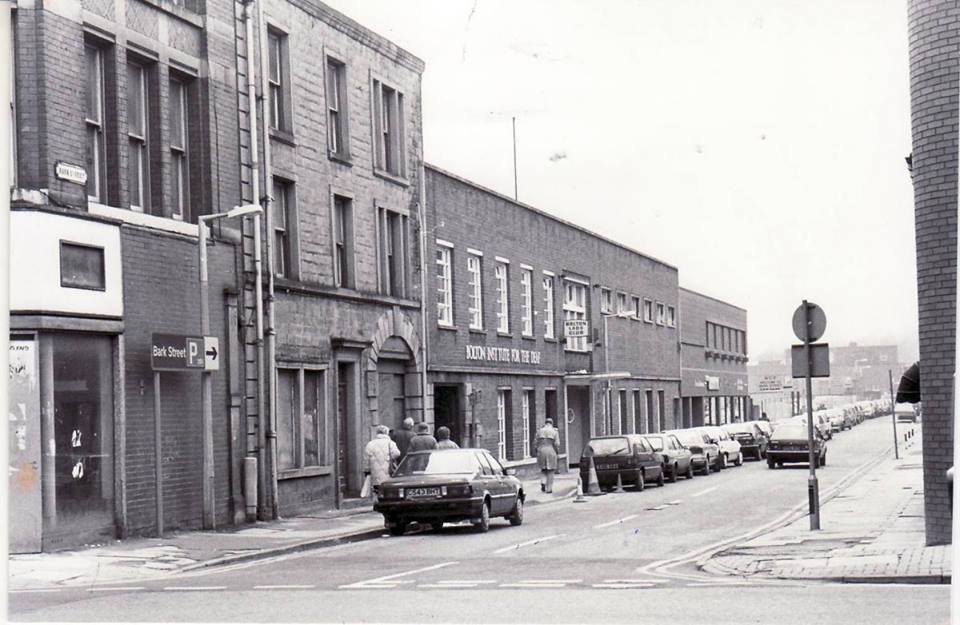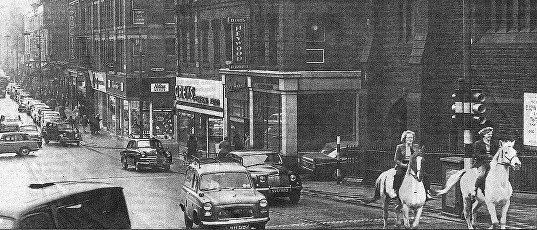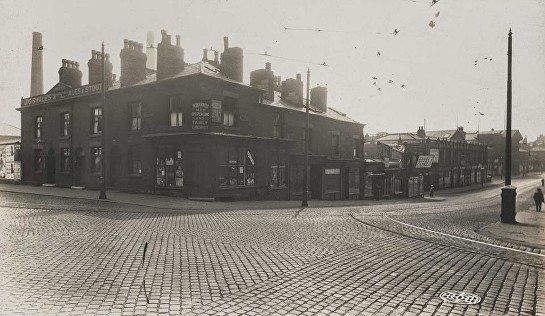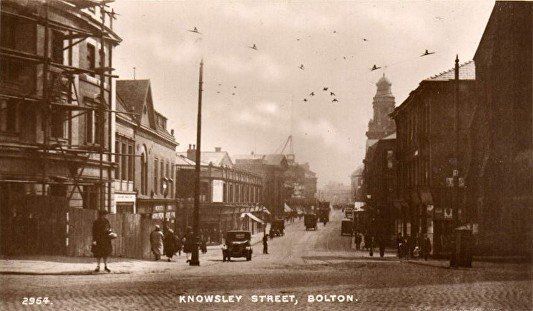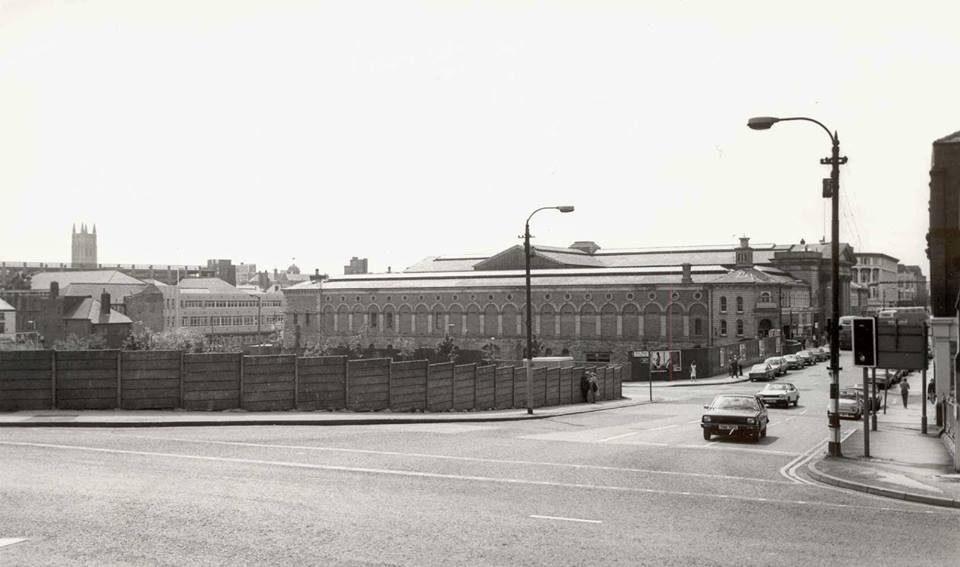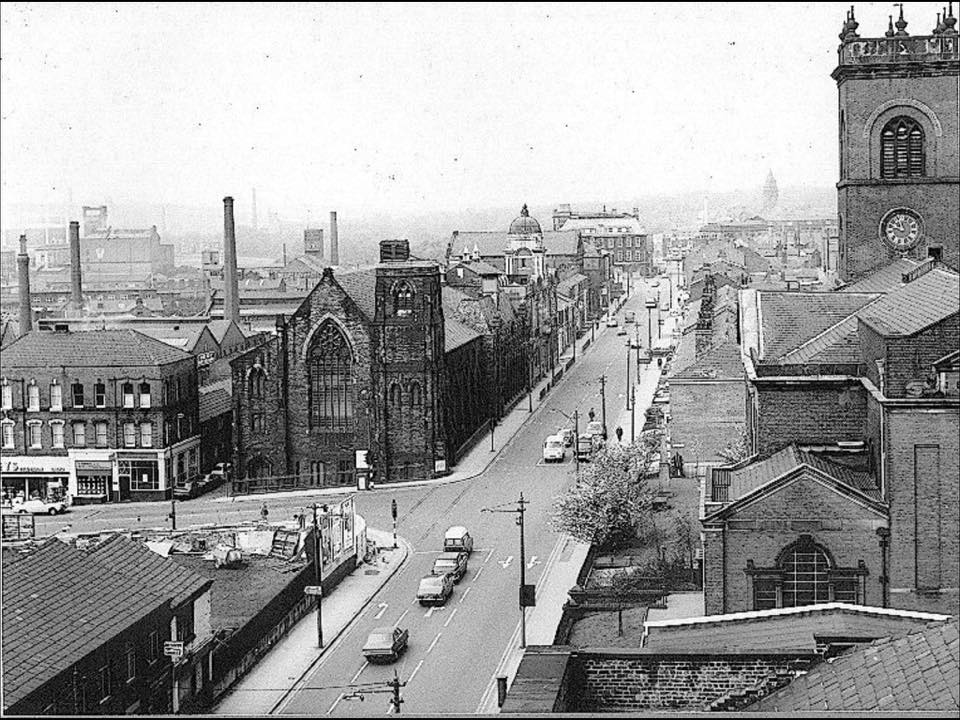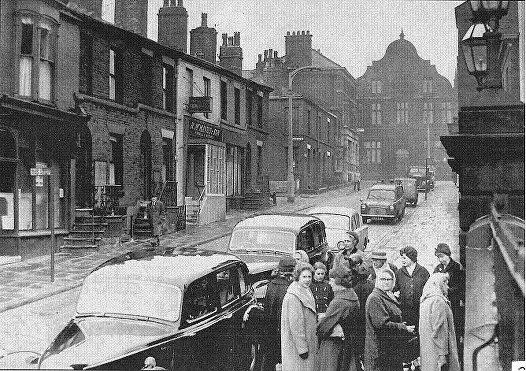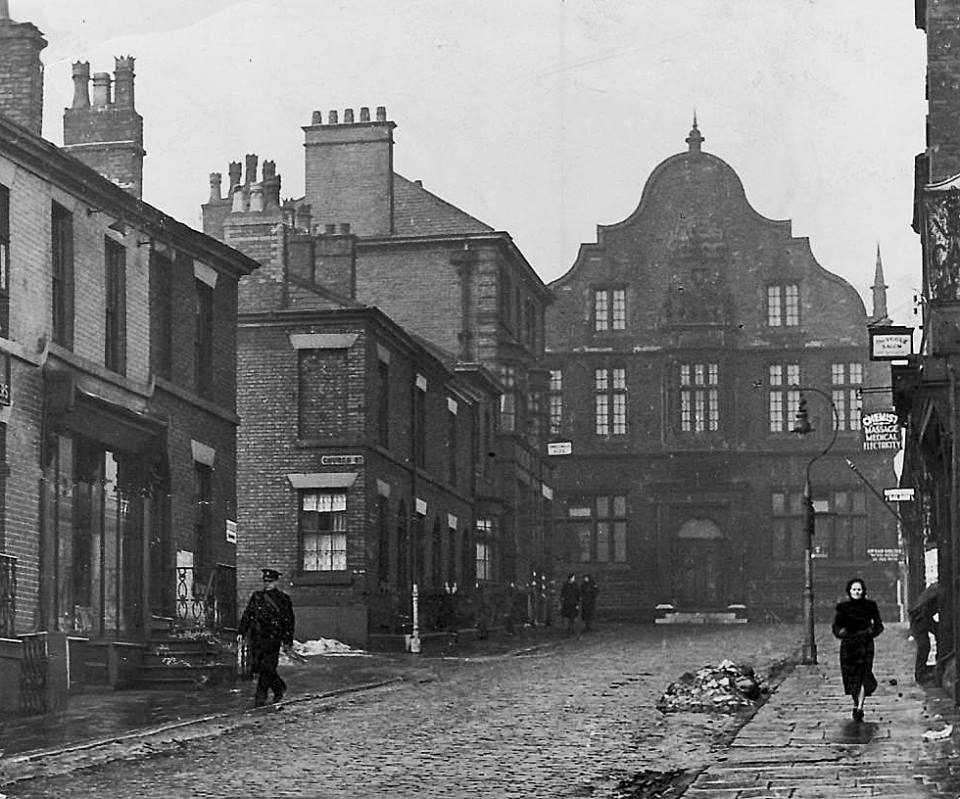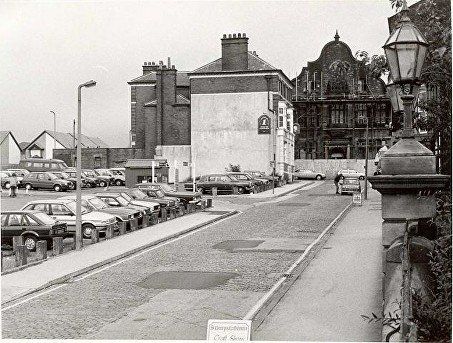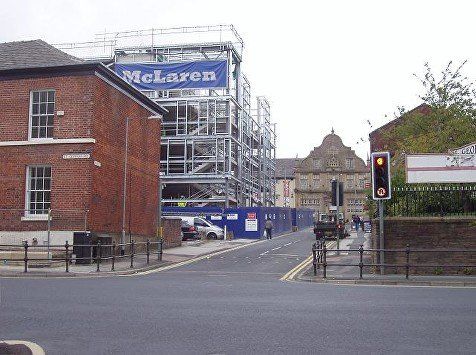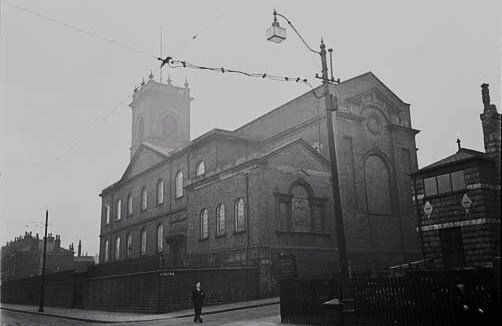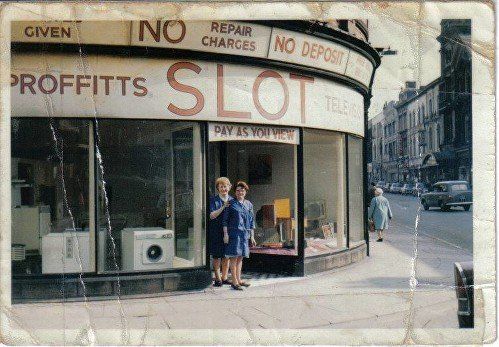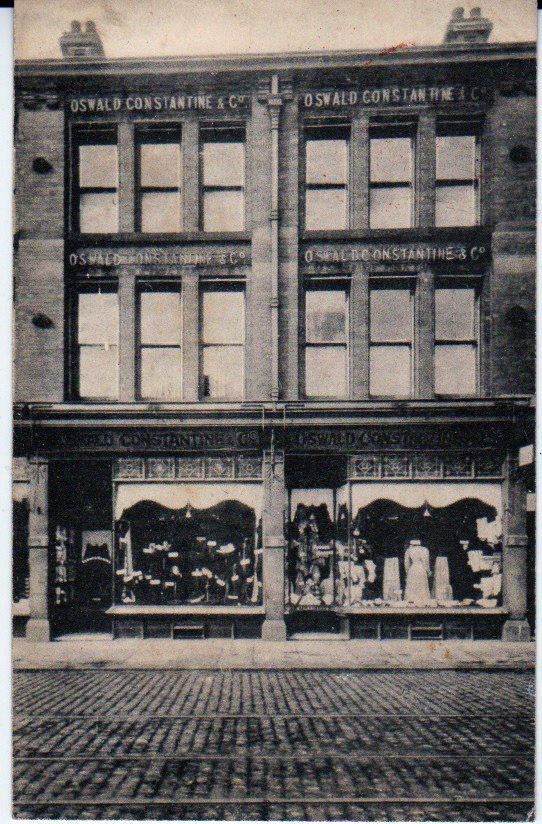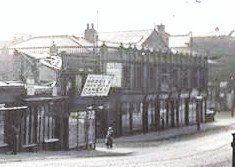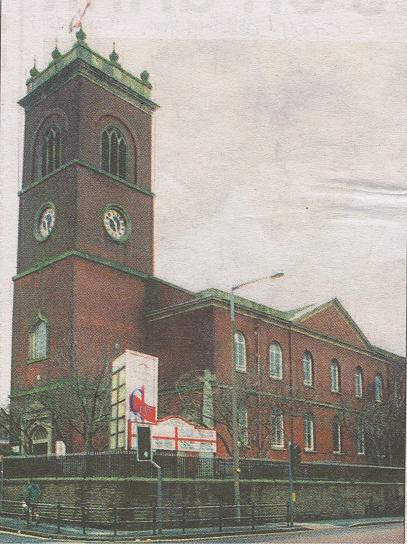21 Knowsley Street
A nostalgic and rather busy memory of Knowsley Street in 1951. Sadly all the buildings on the left as far as the Victoria Hall, or at least their frontages, have been rebuilt.
A collage of two pictures taken within a few seconds of each other. To the left we look along Knowsley Street. The shop on the left corner (Palatine Building, still standing, now MacDonalds) is Burgon’s grocers who had earlier had a shop on the corner of Deansgate and Spring Gardens (Howell Croft North, possibly temporary while work taking place on the Palatine Building).To the right we look along Deansgate with the Paragon on the corner of Oxford Street.
The small low structure between Deansgate and Knowsley Street is the Corporation tram waiting room.
Charlie Higgins was a popular recording comedian from the early to the mid-1930s who disappeared from the national consciousness once he stopped recording. His first record was recorded in 1930. Little is known about him today on the Internet but it is believed he started his career in the theatre during the 1920s. He was born in Liverpool (or Manchester, one source, no date of birth). He was a master of facial expressions when he played the part of someone down on his luck, which could well be why he stars in “Out of Work”. He died in 1978.
The Price of Coal is a two-part television drama written by Barry Hines and directed by Ken Loach first broadcast as part of the Play for Today series in 1977.[Set at the fictional Milton Colliery, near Barnsley in South Yorkshire, the episodes contrast "efforts made to cosmetically improve the pit in preparation for a royal visit (part one) and the target-conscious safety shortcuts that precipitate a fatal accident (part two)".[3]
The plot bears some similarities to the Cadeby Main pit disaster of July 1912, which occurred whilst the King and Queen were visiting pit villages in Yorkshire.[4] This disaster is discussed by managers in the first episode, who refer to the timing of the disaster at the same time as the visit as "bad luck".
The play advertised in the picture above was staged in the late 1920s. It seems inconceivable that the BBC production was not a development of this.
Knowsley Street,
Fifty Shilling Taylor on right corner occupies Knowsley House, the Palatine Building on the left corner is occupied by Redhead’s. The Palatine building was originally four storeys high. Reduced 1908?
Picture posted on Facebook by Denis McCann.
On the left we have Alexandre’s tailors and on the right John Collier’s (the window to watch. The next block down on the left is Horrock’s department store, very popular in the 1950s and 60s, it sold bed linen, curtains and ladies’ accessories like white gloves.
Picture posted on Facebook by Angela Thompson.
Most people do not notice the fine detail on the Palatine building.
This picture posted on Facebook by Gene Watts.
Click on a picture - navigate > < - exit X
1 The Palatine Building retains its original featurse above the ground floor. Some details are shown above. These pictures were taken 20 September 2016. The next block down (beyond Palatine Street), which was Horrock's and is now PoundStretcher was originally built in a style similar to the Palatine. How sad that it was replaced by the present concrete box.
2 Deansgate frontage. What a strange shape the building is. Looks like two separate buildings perhaps not built at the same time.On the right hand part above the first floor window in relief on the stone is PALATINE BUILDINGS.
3 The first floor window with the England three lions in its stonework.
4 A detail on a Knowsley Street window. 5 below: another window detail
Knowsley Street, Picture from David Whenlock's collection.
On the corner is Burgons, groceries and provisions – the notice in the window is offering butter – but the building as a whole is Redhead’s, family drapers, silk stores etc. At this time the building next down the street still exists in its original form similar to the Palatine Building. Further on we see the tower of the Victoria Hall and the spire of the St George’s Road Congregational church and to the right, the tower of St George’s church.
The young lad behind the policeman is the "points boy". He changed the points to ensure each tram went in the correct direction. He has a stick to operate the point levers. In this picture and the next he seems to stay very close to the policeman. Perhaps this is because the policeman would tell him which tram he wanted to let through next. This job was given to a school leaver as a first job on the tramway.
==============================
Another of David Whenlock's pictures. The policeman and the points boy again but looking west along Deansgate towards St Paul's Church.
The correct name for the "points boy" may possibly be "lines man".
Picture posted on Facebook by Angela Thompson.
This picture is earlier than previous ones. Note that the Palatine Building has its original four storeys. On this corner is W L Robertson selling boots and shoes.
Palatine Street divides that from the sadly lost four storey building in the centre of the picture with the ground floor shop on Black and Green, tea sellers.
The date is close to 9 August 1902 and the coronation of King Edward VII and his wife who became Queen Alexander, Edward having acceded to the throne on 22 January 1901 on the death of his mother Queen Victoria.
Knowsley Street. We note the signs placed very high up to Manchester, Preston and Blackburn. The corner extreme right of the picture was rebuilt as Knowsley House 1928-30. The buildings from there to Corporation Street including Dingley’s and Bay’s are rather more interesting than the block that replaced them around 1930 even though that building, which still stands, is a reasonably attractive example of the pseudo-classical style used here and on Great Moor Street at that time. The first two premises have a frontage with a surprising amount of glass! Over the awning of Bays appears to be a seated figure. The writing either side of this could say “Bays for presents”.
Between the Market Hall and the mill building beyond it is a gap which is the course of the River Croal. We notice the man with the watch chain. At least a couple of people on the picture are aware of the camera.
A very busy Knowsley Street, Electric tram though not a single other motorised vehicle to be seen.
Redhead's is in the Palatine Building, now McDonald's. Palatine Street is between that and the "TEA" shop (Black and Greens), now Poundstretcher. Upstairs, Pearl Life Assurance.
c1960, note the buildings on the right dating to c1930. On the left, the Palatine Building has a new frontage at ground level but is unchanged above that. The building next down the street has been demolished and replaced by Horrock's, a typical department store specialising in fabrics, curtains, ladies accessories, very popular and well-known at this time.
On the right, Corporation Street then the Market Hall.
Stylish and attractive buildings on the left. We can clearly see the Victoria Hall, The Congregational Church on the corner of St George’s Road with its spire and St George’s Church. The St George’s Boys’ School is at the top of Bath Street.
Who was I (Sol) Friedman on the corner of Palatine Street? Then a barbers, then Smith & ?,. We have a marble type frontage which does not really match the surrounding buildings, then a building later occupied by Goldings with ornate dormers. It appears to be Boots before we reach the Victoria Hall.
Sadly, none of the buildings this side of the Victoria Hall remain.
A postcard from the collection of David Whenlock.
A similar view in 1951. The buildings remain unchanged from 30 years before but the cars and some of the shops have changed. Shops include Zip, Joan Barrie, Goldings, Proffitt’s.
On the right beyond Bark Street, Proffitt's cycle shop has appeared.
c1950 A clearer view of the shops on the right – the Paragon Building is occupied by T Bullough and Co Ltd selling millinery, underwear, hosiery, costumes. Remelle is on the corner of the Market Hall. On the left Golding’s is still there.
Spender worktown pictures 1937
1980
Everything north of the Croal (on the corner of Knowsley Street and St George's Road, opposite St Georse's Church) has been demolished ready for the building of The Market Place.
24 Sept 2009 (C)WDC
Somewhat different now that the Market Place has been tagged onto the Market Hall.
1929
A quick look back from Knowsley Street across Deansgate into Oxford Street. Tram N for Horwich (Chorley New Rd) Redhead’s on corner
Black and Green is the TEA shop seen earlier on the corner of Palatine Street.
The first street on the right as we go down Knowsley Street is Corporation Street where we will take a quick detour. On the corner at this time is the “Bon Marché” – a name that is familiar on the streets of our own time though there is probably no connection. It seems to sell a full range of clothing items rather than ladies fashion items, though the window display seems to concentrate on underclothes and straw boaters.
Mr Scholes, I guess, at the door of his shop.
I wonder if he, or the next generation, opened Scholes and Scholes in Nelson Square.
The same corner with Knowsley Street up to the right and Corporation Street to the left.
Great Clearance Sale. The block on Knowsley Street is probably about to be replaced by the Paragon Building.
posted on Faceook by Angela Thompson and identified by Wes Halton.
Corporation Street with the Market Hall to the left, Market Street off to the right and a newly built Woolworth's across Bridge Street.
Christmas 1895. The door at the left is 38 Market Street. Corporation Street is to the right.
The same corner of Corporation Street (right and across the picture) and Market Street (left and into the picture). A men’s and boys’ outfitters.
Below - ©Google Street view – the same corner in more recent times. As in other places we see the upper storeys of these buildings essentially unchanged though some minor change may have occurred at the roof line.
16 July 2015 C(WDC) looking further along Corporation Street towards Bridge Street.
May 2018 (C)WDC
And looking back past this good, solid terrace towards Knowsley Street.
A Picture from David Whenlock’s collection of an extremely busy Corporation Street, looking from Bridge Street towards Knowsley Street. R A Hurst poulterer and butcher on the corner, KB indicates a radio and television shop further along.
A little later. A different building on Knowsley Street has been painted white.
May 2018 (C)WDC quite early morning
Now we will have a look at the Market Hall before continuing along Knowsley Street.
<<<<<<<<1991 - Do, you remember the Bolton Journal and BEN offices in the heart of town on Corporation Street opposite the Market Hall? The building was the new branch office of the Bolton Evening News, where advertisements could be placed or accounts paid. It was also the new head office for the Bolton Journal. The offices were open all day Saturday, providing a six day-a-week service. (BEN picture and text.)
corner of Knowsley Street and Corporation Street 1895
The Knowsley Street side of the Market Hall. The parapet of the bridge over the River Croal is immedately to the left.
1997 Knowsley Street, Market Hall, well remembered shops, Hampson’s bakeries, Oxendales locksmiths sadly missed! Stokes opticians with the Paragon Building just visible across Corporation Street.
The Market Hall
The Bolton Market Hall was designed by architect G. T. Robinson, and opened on 19 December 1855. Measuring 294 feet in length and covering an area of 7000 square yards it was said to be 'the largest covered market in the kingdom'. It cost £50000.
A long procession led to the opening ceremony.
To complement the produce stalls and boost custom, a fish market was built next to it which opened in 1865 at a cost of £30000. The fish market was demolished in September 1932.
The market hall was modified in 1894 and further alterations were carried out at the turn of the 20th century. In 1938 the interior layout changed with roofed stalls in tightly packed islands replacing the long rows of stalls and in 1982 a competition brief to redevelop the site immediately to the north of the market hall into a shopping centre was won by Chapman Taylor Partners.
In 1985 Grosvenor Developments took over the Market Place project from Wimpey Property Holdings. The mall hall was refurbished in the 1980s to become the Market Place Shopping Centre and was opened in 1988 by Queen Elizabeth II. In the original Market Hall itself the familiar stalls with roofs (1938) were replaced by more modern brighter stalls in 1987.
Many stallholders had a long association with Bolton Market Hall. At the turn of the century Thomas Coupe set up his stall selling books and music. For a long time it was the only place in Bolton where theatre and concert enthusiasts could buy their tickets. Mr Coupe later opened a music shop in Knowsley Street. He would book a singer and a pianist to give shoppers a little light music as they looked at the stall and those nearby.
A later change to the Market Hall was the removal of the individual stalls to be replaced by big name chain stores along the east and west sides of the Hall with a wide north-south walkway leading from Corporation Street to the new Market Place. This change was met with almost unanimous disapproval at the loss of the individual, sometimes idiosyncratic local traders and such fundamentally useful places as Oxendales, Bobby’s clothes, Spencer Marris cake decorating stall (though the owner of this retired just before the changes) and their replacement by bland chain stores making our rather special Market Hall just like a Mall in any other town. However the latest change – breaking through the floor of the wasted walkway space to give access to the vaults with trendy bars and restaurants has met with much approval.
At one time the vaults were used as a large beer and spirits bottling plant. It was run by George Munro and Company – a firm set up in 1747 which had outlets in Farnworth, Wigan and Blackburn. Their drink was widely sought after at a time when Scotch cost four shillings a bottle and £3 would buy you a dozen bottles of good brandy.
In the 1950s the North West Electricity Board took over part of what had been an ice-making plant under the Market Hall and used it as a garage.
Marks and Spencer opened a stall in the Market Hall in 1892 and this was called Marks and Spencer Ltd Bazaar selling a wide range of small items.
Some people remember animals in cages, probably on the balcony and probably for sale by a local pet shop.
Bolton News (altered and added to)
An early picture of the interior of the Market Hall emphasising the ornate Victorian ironwork.
The interior c1938. This picture emphasises the balconies.
Everybody stood absolutely still as instructed by the photographer - except the man in the middle. There's always one!
This picture is the same as the one above but by closing in and avoiding the glare of the windows we are able to see details much more clearly.
Marks and Spencer Ltd Bazaar which opened in the Market Hall in 1892.
David Whenlock’s picture.
1,2,3 the 1987 renovation, maybe not to everyone’s taste, was quite nice and generally liked, certainly the previous stalls had become very dated.
4. Picture from Wikipedia – the recent almost universally disliked conversion. The individual stalls were done away with. Chain stores filled either side leaving a wide central walkway from Corporation Street to the newly attached Market Place.The central space is sometimes used for temporary exhibitions.
5 May 2018 (C)WDC The large space of this central walkway was cut through to provide access to the vaults (basement, cellars) which had had a number of uses over the years but for the era of separate stalls was used for storage by many of the vendors. I became disused when the individual stalls were removed. The Vaults housed eating places and a children's play area. It became a huge success but as time went by the number of customers reduced and not all eateries could survive. The picture has stairs down to the vaults and escalators either side to the first flor of the Market Place.
6 The Vaults, looking back to the escalator down
7 The Vaults, looking onwards from the entrance.
8 The vaults under the Market Hall, June 1955 when the North West Electricity Board, Number 2 sub-area in Bolton had taken over the former ice-making plant for use as a garage.
Now back into the open air to continue our progress along Knowsley Street.
c1900 An open topped tram on Knowsley Street D for Dunscar.
St George’s Church is visible as is St George’s Road Congregational Church (more recently St Andrew and St George’s URC ) which of course has a spire, removed in 1969 (thanks for date, DD) when dangerous and too expensive to repair.
The tram has a pole to connect to the electricity supply wire which cannot be seen, so date is after electrification, 1900 at the earliest.
September 2009 (C)WDC
On the left all the frontages with different arrangements of windows with arched tops have been replaced with square boxes with square windows. St George and St Andrew’s URC has lost its spire. The trees along the pavement obscure St Andrew’s Church. The Boys’ School (no longer with that function) can be seen at the top of Bath Street and to its left construction of a new multi-storey car park has begun.
Posted on Facebook by Peter Lodge. We note that Boots has a shop here. Golding’s (furniture?) was on Knowsley Street for many years – it has rather ornate dormers
1951 Golding’s has updated its sign, it still has the dormers but they appear to be fewer. The building next this way has taken on a completely new appearance and may have expanded into half of Goldings. Joan Barrie's is on the left.
St George’s URC still has it spire.
1952 The Market Hall is on the right but immediately beyond it where the telephone box is, is a lowish wall which you could look over to see the River Croal 30 feet below.
1900 The opening of the Victoria Hall
1980s
And looking over that wall, this is what you see!! Though shortly before this picture there was a large mill on the left bank. There was a flight of steps down from Knowsley Street to the street alongside the Market Hall which goes to the bottom of Bridge Street. The building is the co-op, now rebuilt and occupied by Argos. The River Croal was already underground for a short distance on the other side of Knowsley Street, but for most of our lives it was open to view at this point. It has now vanished underneath the Market Place. (Picture sent to Bolton Evening News by Brian Harris.)
1985
The culverting of the River croal prior to building the Market Place over it.
Picture ©J&T Davies - used with permission
1966
This is looking from Bridge Street along Brook Street to Knowsley Street, you can see the steps from this street up to Knowsley Street. What we now think of as ground level is actually built up substantially from the original ground. You can drive right under the Victoria Hall to the bottom of Ridgway Gate. We see the mill on the right which was mentioned a little earlier.
Steps up to Knowsley Street with the Victoria Hall opposite.
A clear view of the steps up to Knowsley Street from Brook Street and the roadway beneath Knowsley Street.
(C)WDC May 2018
Those stairs are still there in the basement of the Market Place.
in the 1970s after the mill was demolished. You can now see quite clearly that the whole of Knowsley Street is 20 feet above true ground level on a series of arches. Presume the shops on the other side of the street are built on real ground and below street level must have basements.
Very similar view but after construction of the Market Place has commenced.
Posted on Facebook's Bygone Bolton by Phil Wadeson..
1 and 2: the cobbled River Croal –behind the Victoria Hall as it goes under the shops and Knowsley Street; looking upstream to Ridgway Fold.
3. This picture looks the other way towards the tunnel under the Market Place.
St George’s Church – was completed in 1796 and had a shallow chancel and south chapel added or rebuilt 1907 by James Simpson. Closed as an Anglican place of worship in 1975, it was later leased to the council and turned into a craft centre which for a time housed Stuart Hall’s clock collection. The council’s lease terminated in 2007 and the craft shops were forced to leave. The church was put up for sale at the end of 2008 for £600,000, at which time it had an organ, pulpit, choir stalls and stained glass windows. In January 2012 it again became a place of worship when the Redeemed Christian Church of God, Breakthrough Church moved into the Georgian church after many months of work and many thousands of pounds.
Pevsner: Brick with slate roof and stone dressings. West tower and single span roof over galleried nave, expressed externally as 2 storeys. EXTERIOR: 4 stage tower, with pedimented west doorway with traceried fanlight; iron-framed ogee window above, and clock inset in stone. Triple bell-chamber lights beneath segmental archway in upper stage. Stone parapet with ball finials. 7-bay nave, extended by a single bay to the north-
Text continued below
Sept 2009 (C)WDC
The Market Hall merging into the Market Place.
Over the third bollard is some stonework at the place where you used to be able to look over the wall down to the river.
24 September 2009 (C)WDC
beyond the River Croal,
the top end of Knowsley Street, we can see the URC church, St George's Church which is once again being used for Christian worship, the building of the St George's Boys' School at the top of Bath Street and the new multi-storey car park under construction.
On the left side of the street the buildings this side of the Victoria Hall probably remain as they were originally, not changed by any recent reconstruction.
Then at the red telephone box we have Bark Street (West) then Gregory and Porritt's new building separated by a narrow street from the URC Church.
Knowsley Street, the corner of Bark Street looking east along to All Saints’ Church. The chimney is probably Flax Mill so this picture is before May 1972. Proffitt’s slot television shop has closed and awaits demolition. The mill further down Bark Street is also due to disappear. The market Place now completely covers this area.
Slot television had been very popular, possibly because in the 1950s early 60s people did not have the money to buy a TV outright but in any case, many wanted to try out this new technology because they were not sure they would want it permanently.
Posted on Facebook by Peter Haslam.
Corner of Knowsley Street and Bark Street.This seems to be before the St George Hotel was rebuilt so before 1927 but it may be that the angle is wrong to see it. The co-op drapery tower (later prescription pricing building) just peeps over the roofs at far right. J Morris Cameras, great rebuilding sale. These premises were replaced by those on the next picture.
Posted on Facebook by Gene Watts.
1972 And a very attractive rebuilding too with the new St George's Hotel on the far corner. Presumably J Morris moved in here but by this time it had become Proffitt's cycle shop and sadly was itself about to bite the dust to make way for the Market Place. The white shop to the right seems to be the same building as to the right of the camera shop on the above picture but the premises further to the right have already gone giving a full view of that chimney.
Looking back along Knowsley Street form the St George's Road corner.Not much has changed over many years though in the distance the new Newport Street shops have not yet though the old ones have been demolished. This puts the picture around 1956,57.
Just a little later, the GAME shop has appeared on the corner of Newport Street.
We see Bark Street in both directions
On Knowsley Street we see Fryers, Proffitt’s, William’s has become Kiltie Shoes, Grey’s (television and radio), Doris Heywood (furrier), Vernon Hall (hair stylist), Britannic Assurance and at the top of the street on the left, Rothwell’s chemist. On the right, high up on the corner we seem to have “Medical Eye Centre”.
<<<<May 1965. The slot TV shop is still in business.
Above: David Whenlock picture. Oswald Constantine’s shop on Knowsley Street in the block below Bark Street. We wonder if he was one of the Constantine Brothers whose shop was on Deansgate/Bridge Street later occupied by Woolworth’s.
<<<<a similar view Sept 2009 ©WDC
On the right the buildings this side of the Victoria Hall have not changed but most of the shops have. On the left everything has been replaced by the Market Place. The part of Bark Street on the left no longer exists.
Picture posted on Facebook by Carolyn Haslam.
Corner of Knowsley Street and Bark Street looking west as far as the Marsden Road (High Level) Bridge. The new Gregory and Porritt's building is under construction.
The photographer is standing on the part of Bark Street now obliterated by the Market Place.
Bolton News 1989
Bark Street from Knowsley Street to Chorley Street (this bit still exists).
Bolton Institute for the Deaf and Bolton Lad's Club, then a furniture (?) shop.
The nearer stone building is quite intriguing.
1960 Corner of Knowsley Street and St George’s Road, horse riders, sadly I seem to have no more information about this picture.
1924 The corner of Knowsley St and St George’s Road before rebuilding. The original St George’s Hotel is at the left end of the block.????? MPS dispensing and family chemist occupies the corner.
The camera shop on the near corner of Bark Street is almost demolished.
The block towards the right of the picture beyond Bark Street, survived until demolition for the Market Place. It is a nicely designed and ornamented building that we have only seen indistinctly on previous pictures and would have been well worth retaining. Detail below.
1927 Knowsley Street, postcard, showing the rebuilding of St George’s Hotel.
The shop that became Proffitt's cycle shop is complete. The block of shops beyond Barks Street, mentioned above, is seen again but not clearly.
Building is also taking place at the far end of street, this is Knowsley House on the corner of Deansgate.
The scene as many people remember it before the Market Place.
Pictured in 1932. The building on the corner of Deansgate is now complete.
St George's Hotel about to be demolished, picture posted on Facebook by Gene Watts , the pub had been rebuilt in 1927, it closed in January 1968 and the site was cleared in 1972 however building of the Market Place did not commence until 1985/6. This corner was occupied by Debenham’s until 2021.
1975 Knowsley Street, whole area between Market Hall and St George’s Road cleared.
At the left can be seen the top of the Bow Street multi-storey car park and the tower of the Parish Church.
Picture posted on Facebook by John Westhead
Picture posted on Facebook by Trevor Massey.
The near corner of Knowsley Street and St George's Road has been cleared (1972) but the rest of the block near remains for now.
Grey's is still there. The U.R.Church has lost its steeple (removed in the 1970s). Along SGR we see the dome of the Spinners' Hall and Bolton Workshops for the Blind. The Infirmary tower is just visible through the mist (demolished 1996).
Cross over St George’s Road into Bath Street. We have a group of people outside St George’s Church
Bath Street. Church Street on the left. Does the bricked up window date from Window Tax days (1696 to 1851) or something more local and mundane? Although in the early days of the tax windows were bricked up to avoid paying it, later houses were built with bricked up window spaces in anticipation of glazing subsequently when the tax was repealed.
Clarence Street is across the top of Bath Street with the Clarence Hotel on the corner.
What we can see of the St George’s Boys' School, built in 1847,still a school in the 1960s, is still there but the back half of the building was removed to allow the building of Topp Way in the early 1980s. The building was used as licensed premises under the name Benjamin Topp's for a while.
Clearance of left side of Bath Street being used as a car park, but the Clarence Hotel still stands. All the houses and shops gone. St George’s Boys’ School at the top of the street, built in 1847 is still there but was cut in half by Topp Way in the early 1980s.
Picture posted on Facebook by Gene Watts.
Just to the right along Clarence Street at the top of Palace Street was the Bethel Church. The building, previously a Methodist Church, was a casualty of the building of Topp Way and after some years in porta cabins Bethel built a modern church close by.
Posted on Facebook by John Barnard.
24 Sep 2009 Bath Street multi-storey car park under construction. ©WDC
St George's Church, a fine brick-built Edwardian Church. It was used as a Craft Centre from 1975 to 2008 and for a time housed Stuart Hall’s clock collection. It has been used again as a place of worship since around 2011.
east. Pedimented over central 4 windows each side. Round arched windows with margin lights, the window in the north-east extension in stone architrave. West doors each side, with diagonal panelling and pedimented cases. Interlace tracery in fanlights. Early C20 chancel in flamboyant interpretation of the classical style; Pedimented feature applied to east wall, with round arched main window with oculus above, in segmentally arched recess with elongated voussoirs, and panelled pilasters each side. Venetian window in each wall of south chapel. INTERIOR: 7 bays, with galleries to west, north and south. Wood panelling encasing supporting pillars, and panelled parapet to galleries. Segmentally arched ceiling, divided into plaster panels with simple mouldings. Low stone wall to chancel which is raised up steps flanked by heavy volutes as balusters. Coupled piers divide the chancel into 2 bays, expressed by enriched plasterwork to segmentally arched ceiling. Paired arches to chapel to south, with organ chamber to north. Pilasters flank the east window, which has pictorial stained glass as a private war memorial. Chancel furniture in Renaissance style, including choir stalls and ornate high pedestal pulpit with long curved staircase; altar rails and altar piece with central niche below broken pediment. (BOE: Pevsner N: South Lancashire: Harmondsworth: 1969-).
Bolton News 4 Feb 2010: church may be about to be used again as a place of worship.
St George’s Church, in Bath Street, Bolton, is owned by the Manchester Diocese but may be leased to the Bolton Redeemed Christian Church of God (RCCG).
The church, a distinctive town centre landmark, was built in the 1790s and extended about 100 years ago but has not been a place of worship for three decades. The grade II listed building was used as an Anglican church until 1975, then later leased to the council and turned into a craft centre.
But the building has been empty since 2007 when craft shops were forced to leave because of the termination of the council’s lease.
St George’s still has an organ, pulpit, choir stalls and stained glass windows. The church was put up for sale at the end of 2008 for £600,000. The news has been welcomed by Cllr John Walsh, who was the last church warden at St George’s and would welcomes a return to worship. He said: “If it goes back to a centre for Christian worship then I would be very happy. It is looking in a very sorry state at the moment so for that reason I would be pleased to see an alternative use found.”
The RCCG, a growing evangelical movement, has four churches in Bolton.
A statement reads: “Join us in acquiring St George's Church. This gigantic building is strategically located within the town centre. “We believe this is an historic moment.”
Manchester Diocese will lease the building to the RCCG if the proposals are approved by the Closed Churches Division of the Church Commissioners.
Bolton News 12 Jan 2012 A CONGREGATION has transformed an empty town centre church back to a place of worship.
The Christian group, led by Pastor Adewale Adeleye, spent thousands of pounds and several months repairing and working on St George’s Church in Bolton town centre. It is the latest chapter in the history of the prominent church, which has lain empty since it was last used — as a craft centre.
Now, five months after the Redeemed Christian Church of God Breakthrough Church first moved into the transformed Georgian church, it is planning a special opening service — and wants to invite the people of Bolton to attend.The expanding group started worshipping in the YMCA building, before moving to a larger space at Gilnow Mill on Spa Road, and then to St George’s Church.
Pastor Adeleye, aged 44, moved to Farnworth from Nigeria in 2004, and has been pastor of the Pentecostal congregation since 2005. The father-of-three discovered St George’s Church when it was being used as a craft shop and fell in love with the building. After it came up for sale, the congregation won planning permission to transform it back into a church then raised a deposit to buy the building. They have since spent thousands of pounds on the church’s heating, electricity, carpets, chandeliers, toilet facilities, repairs to broken windows, and repainting and plastering of the walls. They also repositioned the church’s historic pulpit, at a cost of £7,000.
Pastor Adeleye said: “We had to do a lot of work to make it a habitable place of worship. It was a massive job and it was overwhelming at first but we all did it together."

